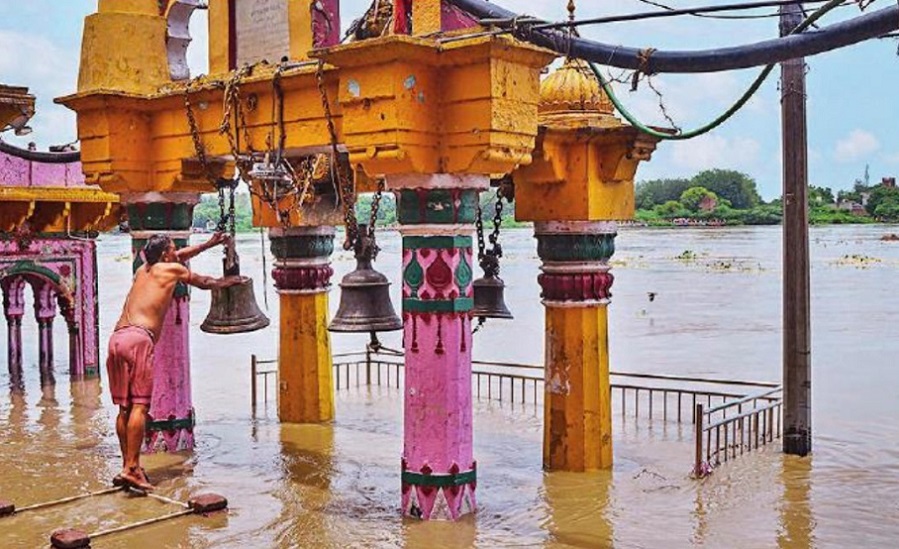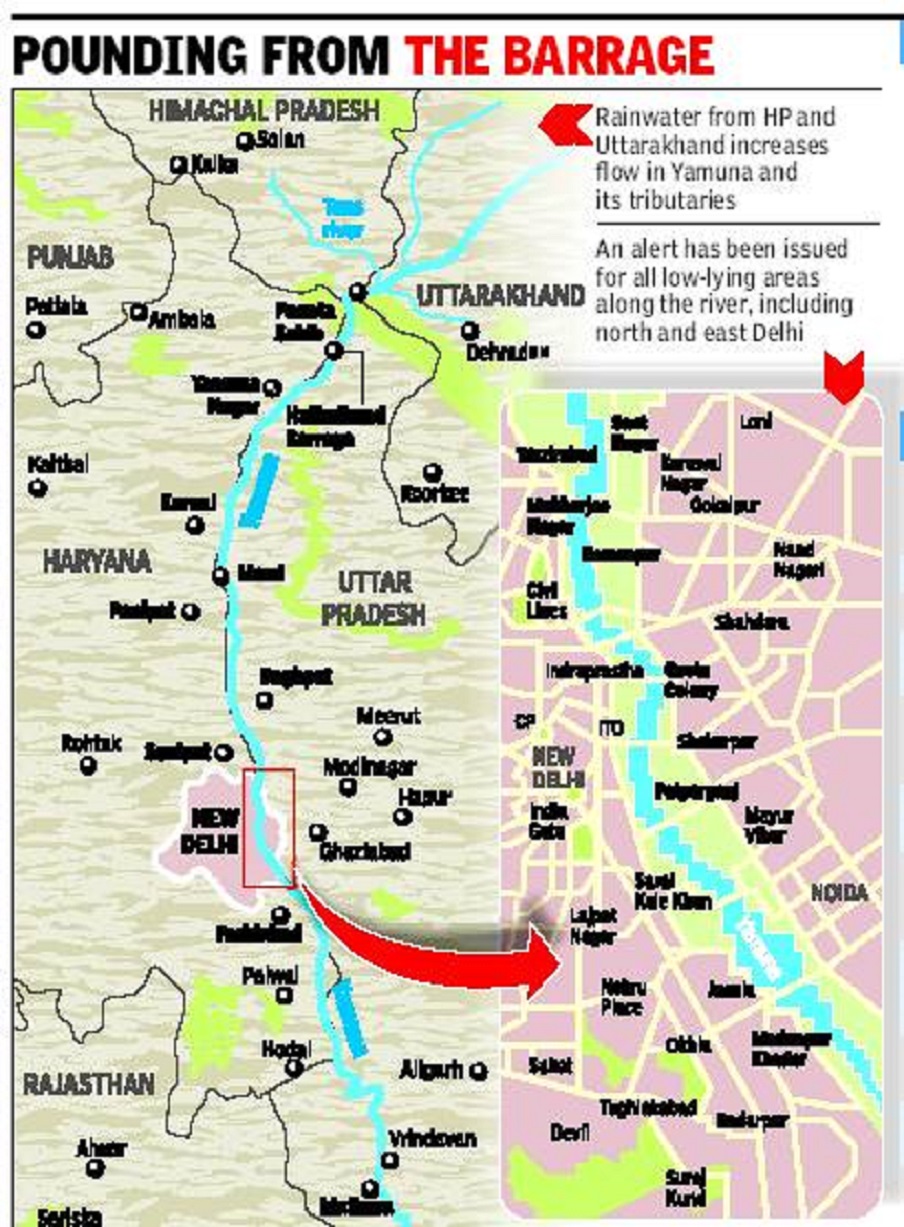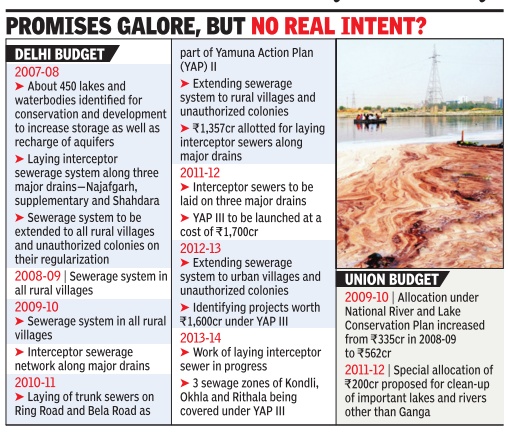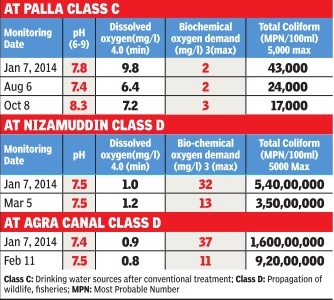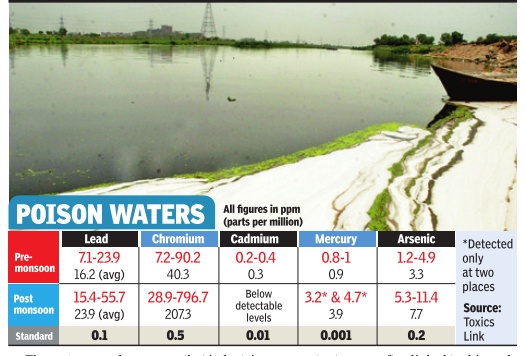River Yamuna
This is a collection of articles archived for the excellence of their content. |
The course of the Yamuna
The state of the river/ Water quality
see the graphic, "The Supreme Court and the Yamuna, over the years"
Why the Yamuna is dead
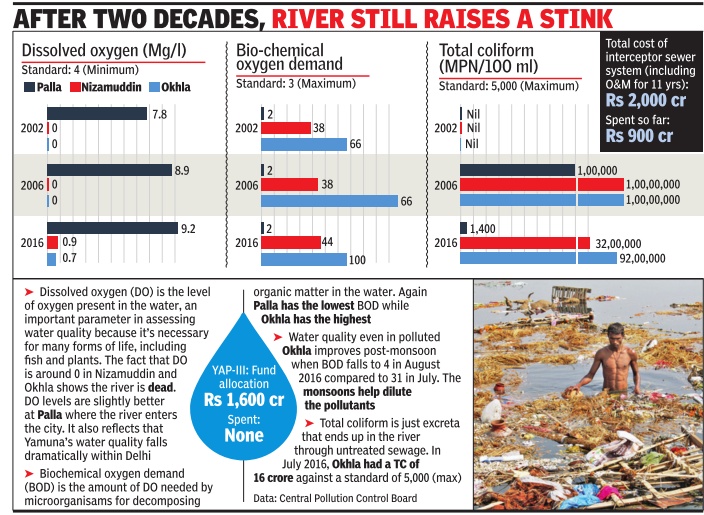
The city has spent over Rs 2,000 crore on Yamuna clean-up in the last 22 years.This shocking revelation came during a hearing in the Supreme Court. The reality becomes starker when you consider recent and past data that show no improvement in water quality: total coliform, or mostly human and animal excreta, continues to be in lakhs, and even crores, when the standard is a maximum of 5,000 mpn100 ml (most probably number100 ml). Also, dissolved oxygen (DO), a must for many forms of life in the water, continues to be negligible, which reiterates that it's a dead river. DO levels in March months of 2002 and 2006 at Nizamuddin and Palla were 0; in 2016, these were 0.9 and 0.7, respectively .Total coliform levels went up to 16 crore in June last year. No Yamuna cleaning project has managed to bring a perceptible difference to water quality .Apart from Yamuna Action Plans on which the bulk of funds were spent, the National Green Tribunal, in its 2015 judgment, had ordered augmenting the functioning of sewage-treatment plants that are running under capacity and constructing 32 smaller STPs in a decentralised manner.
“According to DJB, there are 23 STP's planned and existing as of today in Delhi....the oxidation pond at Timarpur, which was commissioned in 1947, is proposed to be closed.There is an STP at Okhla, which was commissioned in 1937, and four STP's at Kondli are lying closed due to inadequate sewerage...the entire STP infrastructure, if made fully functional, can be utilised to support and aid implementation of the project,“ NGT had said. There is no implementation of this order so far. Delhi Jal Board claims that it has the capacity to treat 604 million gallons per day of sewage, of which it is treating about 75%.
Brij Gopal, former JNU professor and member of NGT's expert panel on Yamuna, said: “Nothing has moved.Sewage is not even reaching the STPs. If untreated sewage is flowing down the drain, what do you expect? Plus there is no flow in the river.“
Under phases I and II of the Yamuna Action Plan, launched in 1993, Rs 576.73 crore has already been spent. Under YAP-III, an additional Rs 1,600 crore has been allocated, which is yet to be used.
“Yamuna, like all of Delhi, has suffered due to multiplicity of agencies. Crores were definitely allocated but the money was used incoherently . DJB was doing something while the corporations were doing something else. We are hopeful now that the interceptor sewer system, when it is completed by next year, will finally clean the river,“ said a senior government official.
Experts also say that policies to clean Yamuna have only been STP-oriented when the biggest issue is the fact that the river has no water or ecological flow. SC, in a 1998 order, had directed that 10 cumecs of water be released into the river through the year. Experts feel that 10 cumecs is inadequate, but as of now even that is not being released. Following NGT's 2015 judgment, about 10 cumecs is being released at Hatnikund, but that reduces significantly as it flows downstream. “The only answer to this is to ensure more water is released. Sewage treatment alone cannot ensure unhindered flow“ said Manoj Mishra of Yamuna Jiye Abhiyan, who had moved NGT on Yamuna pollution.
Meanwhile both Centre and Delhi government have an nounced several cosmetic measures. For example, last year, Centre launched a trash skimmer to clean the water surface and announced a “proper“ chhat ghat. In an effort to develop the river front, Delhi government started a Yamuna Aarti and developed a `Nakshatra Vatika' along the river bed.
Union water minister Uma Bharti had announced last year that Lakhwar Vyasi Dam in Uttarakhand would release water in Yamuna during lean season, which was contested by environmental experts because the project is unlikely to get environmental clearance.
2010-17: Oxygen levels show why Yamuna is practically dead
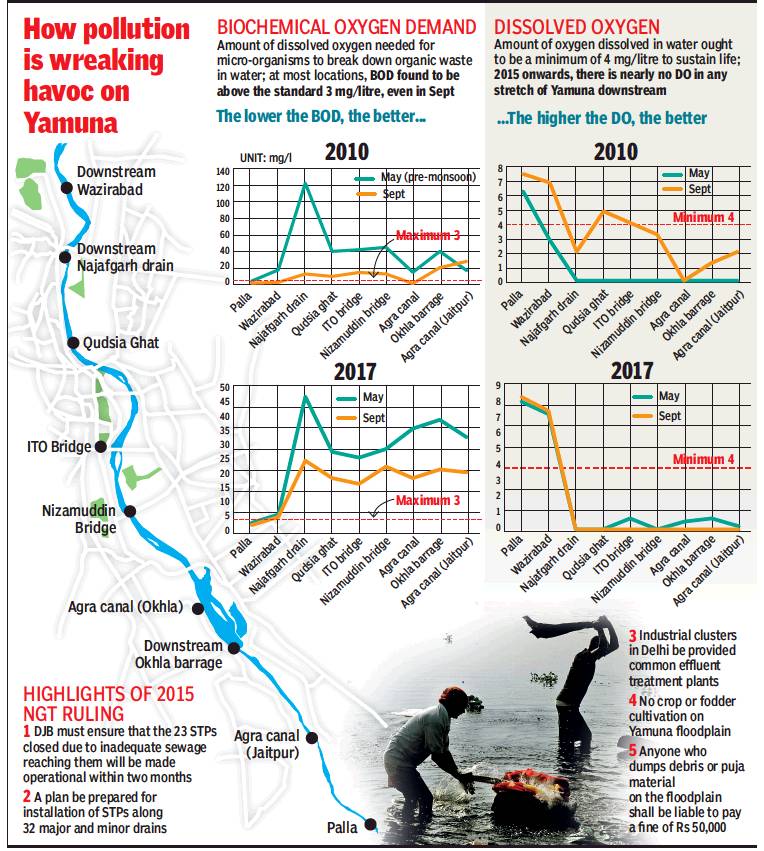
From: Jayashree Nandi, Oxygen levels show why Yamuna is dead for all practical purposes, August 27, 2018: The Times of India
Intensity Of Pollution Has Risen In Last 5 Years Or So
Despite several SC and NGT orders, almost the entire stretch of Yamuna in Delhi continues to be severely polluted. In fact, the intensity of pollution may have increased in the last 4-5 years, an analysis of the Delhi Pollution Control Committee’s Yamuna water quality data has revealed.
For example, dissolved oxygen (DO) levels — the amount of oxygen dissolved in water — ought to be a minimum of 4 mg/litre, but 2015 onwards, there is nearly no DO in any stretch of Yamuna downstream, even in September (post-monsoon).
The pre-monsoon data of May from 2010 to 2018 also shows DO levels to be nil everywhere except in Palla and Surghat (downstream of Wazirabad barrage) where Yamuna enters the city. DPCC’s data reveals that while pollution levels haven’t improved, they may have actually deteriorated further in most stretches as the inflow of sewage increased over the years.
Now, all eyes are on two interventions — implementation of National Green Tribunal’s “Mailey se Nirmal Yamuna” and laying of interceptor sewage lines along Delhi’s three biggest drains, likely to be completed by January 2019.
Recently, Delhi Jal Board had submitted its draft report on sewerage management and performance of sewage treatment plants to NGT, which revealed that, at most places, the biochemical oxygen demand (BOD) — the amount of dissolved oxygen needed for micro-organisms to breakdown the organic waste in water or, in simple terms, oxygen needed by the river to sustain life — did not meet the standard (it should not exceed 3mg/litre).
In lay man terms, the lower the BOD, the better it is for river life. On the other hand, the higher the DO, the better it is.
Most STPs are either closed or working way below capacity. Out of a total of 607.06 million gallons per day of operational capacity, only 476.74 MGD sewage is treated. “We have already recorded a clear finding of the failure of the administration in handling the situation and repeated failure in carrying out binding directions in various orders,” a bench headed by chairperson Adarsh Kumar Goel said recently while evaluating the implementation of NGT’s January 2015 order on a decentralised sewerage system where sewage falling into all drains is tapped and treated.
NGT constituted a committee that will monitor compliance with the order on a day-to-day basis. The committee comprising Shailaja Chandra, former chief secretary, Delhi, and BS Sajwan, former principal chief conservator of forests, will take stock of all action taken so far to comply with the January 2019 order.
The mandate of the committee will be to ensure safe standard of water quality at the entry and exit points of Yamuna in the long run. The committee may also consider approving collection of funds for the project by applying the “polluter pays” principle, the NGT order said.
They will also conduct regular inspections and analyse pollution levels with assistance from CPCB. “We are hopeful that this monitoring committee will ensure implementation of NGT’s Yamuna order because the committee members are retired and not working in their official capacity unlike the previous committee. NGT has also said that this committee will monitor implementation on a day-to-day basis. As far as DPCC’s data is concerned, it’s no surprise that even in September, DO is nil. It shows that intensity of pollution and sewage entering the river has increased. Yamuna, downstream of Wazirabad is all sewage except during monsoon,” Manoj Mishra of Yamuna Jiye Abhiyan said.
2011: assessment of water quality

6,500cr and 19yrs later, Yamuna dirtier than ever/ Clean-Up Plan Flops, SC Review today
By Neha Lalchandani 2013/03/11
[In 1994?] the Supreme Court first scrutinized pollution in the Yamuna. Innumerable orders later, Yamuna is dirtier than ever with a mind-numbing Rs 6,500 crore spent to clean the river and the latest plan — interceptor sewers — going
When SC reviews Yamuna’s pollution, it could be back to the drawing board. Six years after the Delhi Jal Board proposed interceptor sewers to treat sewage before it flows into major drains, just Rs 51 crore of the Rs 1,963 crore scheme has been spent.
Worse, it is not even clear if the measure that was to improve water quality by 2010 will actually work in light of the rapid growth of unauthorized colonies discharging sewage into the river, an issue flagged even in 2007 by an official committee that approved the interceptor proposal.
The committee had warned that 1,432 unauthorized colonies were the nub of the problem. By 2012, their number had jumped to 1,639. Although these colonies have been promised regularization, drainage and sewers are years away. In 2007, 517 of 567 unauthorized regularized colonies had sewers. The number grew by just six in the next five years. DJB says it is tough to provide sewerage in such densely populated colonies where they have barely any road space for their work.
A report submitted to the court by an inspection team that included amicus curiae Ranjit Kumar as recently as November last year called for sewage connections to all new colonies, whether authorized or not.
It pointed out that Delhi’s 17 sewage treatment plants (STPs) have a capacity of 2,460 MGD against utilization of 1,558 MGD. Delhi’s sewage generation is around 3,800 MGD.
Throwing money in the river
6,500cr spent by Delhi, UP and Haryana to clean Yamuna. This includes central funds. No improvement in water quality in past 8 yrs Only 51cr of 1,963cr sanctioned for interceptor drains spent. Scheme proposed in 2007, was to deliver results by 2010 Number of unauthorized colonies has jumped from 1,432 in 2007 to 1,639 in 2012
Only 55% of Delhi’s population served by sewer system
Delhi’s installed sewage treatment capacity is 2,460 MLD. Sewage generated is 3,800 MLD. But just 63% of installed capacity is being used
City’s biggest drain, Najafgarh, discharges 2,064 MLD. Only 30% is treated.
Worse, treated sewage is again mixed with waste
SC-mandated team inspected 4 sewage treatment plants in November 2012.
All four were deficient
Heavy metals in city’s drinking water
Delhi’s drinking water is contaminated with tonnes of industrial waste. Industries located upstream of the Yamuna have been found to be discharging untreated waste into the river, leading to the presence of heavy metals in water that is picked up at Wazirabad to meet the city’s drinking water needs.
Manoj Misra of the Yamuna Jiye Abhiyan had water from the Dhanura Escape — a channel that empties into the Yamuna — tested at a laboratory in Gwalior and found that the levels of chromium, lead and iron were higher than permissible. “While chromium was 0.13 mg/l against 0.05 mg/l, lead was 0.035 mg/l against 0.01mg/l and iron was 3.51mg/l against a permissible 0.1 mg/l. The presence of heavy metals is even more problematic since the treatment plants in Delhi are not equipped to detect or treat them,” said Misra.
Pollution from industries in Haryana, especially those located in and around Panipat and Sonepat, has caused treatment plants to stop functioning on several occasions after ammonia level went so high that it could not be treated. Untreated industrial effluent from Yamuna Nagar, Misra said, is released into the Dhanura Escape from where it meets the river upstream of Kunjpura in the Karnal district.
“Similarly, toxic waste from Panipat falls into the Yamuna near the village of Simla Gujran in Panipat district. Samples from the Dhanura Escape show presence of heavy metals, known health hazards and a clear indication of industrial pollution. This water is picked up at Wazirabad for treatment at Chandrawal and Wazirabad treatment plants,” he said.
Other than heavy metals, other pollutants, too, were much higher than BIS norms for drinking water. Total coliform was 1,200 against the permissible limit of 10, total dissolved solids were 3,324 against the permissible limit of 500, biochemical oxygen demand was 240 mg/l against a limit of 30 mg/l, and chemical oxygen demand was 768 mg/l against a limit of 250 mg/l, Misra added.
Central Pollution Control Board officials said they had made it compulsory for all industries to have effluent treatment plants. “Most industries have installed ETPs but either the treatment is not up to mark or not all effluent is reaching the ETPs. We have set up a real time water pollution monitoring station at Wazirabad where we monitor 10 parameters... heavy metals are not monitored as they cannot be treated in the plants,” said an official.
The wish list
Haryana government release more water from Hathnikund Barrage for Uttar Pradesh
Alternate arrangement be made for disposal of untreated sewage in Delhi, which is at present dumped into the river at 22 places
The holy river be given due respect
2017: assessment of water quality, using sensors
Jasjeev Gandhiok, How dirty is Yamuna? A boat ride tells you, April 2, 2019: The Times of India
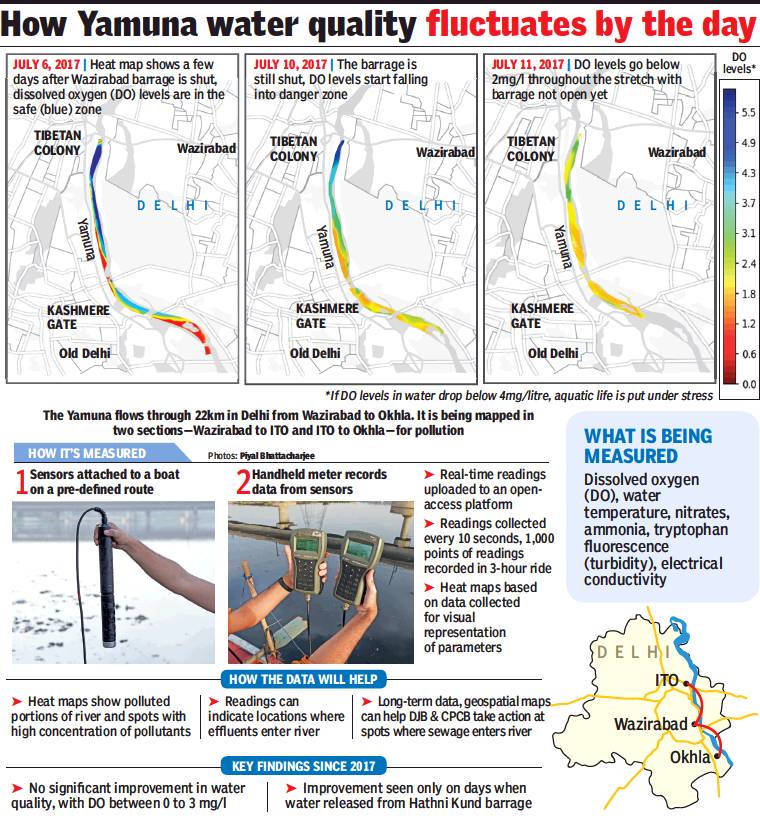
From: Jasjeev Gandhiok, How dirty is Yamuna? A boat ride tells you, April 2, 2019: The Times of India
New Technology Uses Sensors To Analyse Spots Where Pollution Is Highest
A boat ride down the Yamuna in the capital provides visual proof of how polluted the river is. But a new technology quantifies this presence of pollutants. The “Water-to-Cloud” tech uses sensors attached to the boat. When the system traverses the riverine course, the sensors send real-time readings to a hand-held device that allows researchers to analyse the spots along the river where the pollution is highest.
For over two decades now, the concentration of pollutants in the Yamuna has been steadily rising, with no decrease in the industrial and sewage discharge into the river despite preventive measures taken various agencies. The new technology developed by the University of Chicago’s Tata Centre for Development can pin-point where the pollutants are entering the river.
As TOI found out when it took a ride with the research team recently, the sensors are cyber-physical, meaning they are mechanical but monitored on computers and integrated with the internet. They test the water quality on parameters like dissolved oxygen (DO), nitrates, ammonia and turbidity, among others. Priyank Hirani, team head of the Water-to-Cloud project, explained that the data collected are translated into geo-spatial maps and heat maps that visually represent the parameters and facilitate a better understanding of the river’s character.
“We have been gathering data since 2017. Every time we take a ride, we try to take a different route down the river,” said Hirani. “The idea is to cover the entire river so that we can generate an accurate heat map. The more the data generated, the easier it is to learn which portions of the Yamuna need attention. We also identify areas where the pollutants are entering the water.”
The team generally opts for two routes, one from Wazirabad barrage to ITO, and the other between ITO and Okhla barrage. While the biological oxygen demand (BOD) cannot be measured in real-time, pseudo indicators — like tryptophan, an amino acid found in proteins — are used to understand the real-time surrogate value of BOD.
The sensors collect data every 10 seconds on the ride, which is usually of three hours’ duration. “Over 1,000 data points are captured during a typical ride. Since 2017, we have generated data for different seasons and different times of the day. For parameters that cannot be measured in real time, we collect water samples for analysis in the laboratory,” said Hirani. The team found that there is only a plus-minus 10% difference between realtime readings and readings determined in the lab.
The Tata Centre for Development at University of Chicago is being jointly assisted by the International Innovation Corps on this river exercise. Himank Sharma, who is jointly heading the project, said that the plan is to collect more data before consolidating everything into a report which will be submitted to agencies like Delhi Jal Board and Central Pollution Control Board.
“Since the middle of 2017, we have gathered 59,568 data points for the Yamuna,” said Sharma. “This data is currently accessible on our website and we encourage other agencies and organisations to contribute and help improve our database.”
Domestic detergents raise phosphate levels/ 2020
Jasjeev.Gandhiok, August 4, 2020: The Times of India
High phosphate levels, primarily due to use of domestic detergents, is causing frothing in the Yamuna, Delhi Pollution Control Committee informed the National Green Tribunal-appointed Yamuna Monitoring Committee, which had sought a detailed report on why frothing was being seen in the river.
Both DPCC and the Central Pollution Control Board had been asked to look into the matter, after images of froth in the river went viral on the social media.
DPCC officials conducted a site visit and detected froth at locations where there was a change in the level of the river, or where new water was being introduced. “The river was found to be having high phosphate content, which primarily comes from laundry detergents. There is no froth formation when there is a normal flow, but if there is a change in elevation or new water is introduced, the phosphate rises to the surface, mixing with the water to create foam on the surface,” a DPCC official explained.
On July 24, Delhi Jal Board had curtailed supply at Okhla, Wazirabad and Chandrawal water treatment plants due to the presence of high levels of pollutants in the Yamuna.
DPCC officials claimed there is no immediate solution to the problem, with an increased flow of water likely to help reduce the froth. “ In the long term, only the completion of tapping each drain with Sewage Treatment Plants (STPs) will remove this problem,” the official added.
“A large chunk of the pollution in the river actually comes from domestic sewage and not industries. Tapping both sources is essential and that will still take a couple of years. Until then, frothing will continue to occur at times,” said the official. Yamuna Monitoring Committee, which had been appointed by NGT in 2018 to rejuvenate the river, was re-appointed last month and has since directed CPCB and DPCC to carry out monthly monitoring of the Yamuna and to provide data each month.
AN OFFICIAL SAYS
In the long term, only the completion of tapping each drain with STPs will remove this problem
The water has not improved despite generous funds
WATER QUALITY WORSE - Funds flow, Yamuna stays filthy
Jayashree.Nandi@timesgroup.com New Delhi
The Times of India Jul 15 2014
Every year the state and union budgets raise hopes that the Yamuna may after all soon get a new lease of life. In fact, the Delhi government's budget has been making the exact same promise for seven years (2008-14). Providing sewerage in urban villages and unauthorized colonies and laying interceptor sewers along major drains is its solution for Yamuna's pollution crisis. It has allotted over Rs 3,500 crore for these projects--mostly under the Yamuna Action Plans--to complete the work and ensure “discharge of pollutants comes down considerably“.
But 2014 Yamuna water sample investigations by Central Pollution Control Board (CPCB) show levels have not improved; they are worse at some sites. Delhi Pollution Control Committee (DPCC) officials also confirmed to TOI that water quality parameters including biological oxygen demand (BOD) and total coliform levels have only deteriorated or are the same in almost all monitoring sites.
Interestingly , Delhi Jal Board (DJB) claims that 68% of the work of laying the interceptor sewer--large sewer lines that control the flow of sewage to a treatment plant--is already done. The project is divided into packages, out of which two will be completed by the end of 2014 and the rest by 2015. It also claims that of 2,574 urban and rural villages, unauthorized colonies and other un-sewered colonies, sewerage was provided in 842.
But no one seems to be sure why water quality hasn't started improving. One of the reasons, say officials, is that these projects will work only when sewage treatment plants func tion to their full capacity. As of now, most STPs are functioning at 50% capacity .
The funds allocated by the union government are also difficult to track. “The union government for instance allocated Rs 562 crore for rivers in 2009 and Rs 200 crore in 2011 for lakes and rivers and Rs 100 crore for “ghat development and beautification“ for seven river side cities including Delhi this time.
Barapullah drain
Steps by the Indian government
The Times of India, December 20, 2016

India, Holland tie up to clean Barapullah drain
Vishwa Mohan In what could be the first real proof that reviving the Yamuna in Delhi is possible, India and Netherlands have joined hands for cleaning of the Barapullah drain, responsible for nearly one-third of the waste that is dumped into the river which courses through the capital.Not just that. The focus will also be on generating safe water from sewage streams for reuse in areas like agriculture, relieving somewhat the water scarcity that dogs the city.
The idea is to make the project functional in three years. It is expected the project will reach its full capacity within five years when it will also be able to produce bio-gas and generate water for agriculture use. Under the project, a pilot sewage treatment plant (STP) will be set up and operated along the drain near Sarai Kale Khan with the support of the Dutch and the Indian consortium.
Scientists from IIT, Delhi will be part of the project.
The practical expertise generated through this pilot plant will focus on finding cost effective local solutions and adapt state-of-the-art Dutch technology to Indian conditions for the cleaning of the drain. The technologies will further be developed to gene rate safe water for reuse.“This is a very ambitious project and I am really hopeful that this will reap good results in a very short time“, said K Vijay Raghavan, secretary of the department of biotechnology (DBT), ministry of science and technology .
He said, “What we are experimenting with is to use a decentralised approach towards sewage treatment plants as well as implement new technologies“.
The project is part of a collaboration between the DBT and the Netherlands Organisation for Scientific Research and Technology Foundation.Scientists from both the countries already had a two-day workshop on the project here recently when they discussed the time-line and logistics.The estimated cost of the project is around Rs 21crore.
Focus on the Barapullah drain through such joint venture is, however, just a component of a larger plan to clean the river Yamuna by the government. There are 21 major waste water drains in the capital. Eighteen out of the 21empty their waste into the Yamuna while the remaining three join the AgraGurgaon canal.
Najafgarh and Shahadara are the other two other big drains which open into the Yamuna in Delhi where the river traverses a distance of about 46 kilometres.
Rejuvenation a success
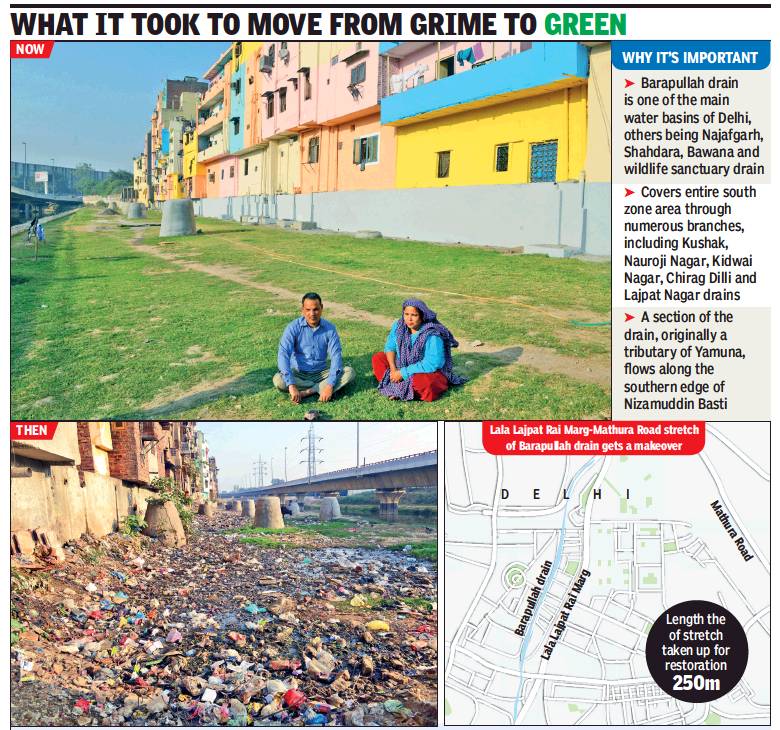
From: Richi Verma, From drain to sewer and back: The story of Barapullah rebirth, January 1, 2018: The Times of India
Four-Year Project Revitalises 250m Stretch Of Nullah, Surrounding Areas
Years of garbage, filth, slum waste and sewage dump made Barapullah Nullah one of the biggest eyesores of the capital. But after some painstaking work, the drain and its surrounding areas near Nizamuddin Basti have been rejuvenated through a massive four-year project that has involved not just cleaning and revitalising both sides of the drain, but also working with the community living close to it for a greener and cleaner environment.
The project is a part of the Nizamuddin Urban Renewal Initative, undertaken by Aga Khan Trust for Culture, with the support of the Norwegian ministry of foreign affairs. Officials said restoring this 250-metre stretch of the drain and its surrounding areas would rank as one of the most difficult tasks that the Nizamuddin Urban Renewal Initiative took up — in terms of the complexity of the task involved, number of team members involved and the arduous working conditions.
One of the main natural water basins of Delhi, the length of the Barapullah Nullah is more than 300km. The restoration work was taken up on the section between Lala Lajpat Rai Marg and Mathura Road. “This stretch, originally a tributary of the Yamuna, flows along the southern edge of Nizamuddin Basti. Over time, this historic nullah, which used to carry rainwater, became a grimy drain with waste water, solid waste and sewage. In the past few years, the Barapullah elevated road was built over portions of the nullah,” said an AKTC official.
Once the project was conceived, one of the challenges was to involve the community living along the nullah and discourage them from dumping garbage there. AKTC officials also targeted the facade of the houses along the nullah. “They were like an amorphous accumulation of unfinished blocks with most of the exterior unfinished — adding to the slum-like image of the basti,” said an official. The facade was given a facelift with a comprehensive repair and paint job. The next task was to complete the draining of the central channel, grading the existing earth levels into terraces and lining them with a retaining wall of dry stone masonry.
The toughest job, however, was to link the toilets in all the 144 households to the main trunk sewer rather than have them dumping human waste on the nullah banks. Delhi Jal Board relaid the sewerage line. Next, all households had to be convinced to contribute towards this process by paying a small portion of the cost, pledging not to dump garbage into the nullah and promising to give household garbage to waste collectors appointed by AKTC — another programme where waste is collected at the household level on a costsharing basis.
Many houses did not have dustbins and these were provided to them as an incentive. The land around the nullah had to be cleaned up and while plantation of trees is also planned, officials said, they have to ensure the saplings are eaten up by cattle.
The project, which started in 2014, involved coordinated efforts from multi-disciplinary teams. The engineering team worked on the nullah, connecting households to the sewer and on improving the facade of the houses; the horticulture team worked on the nullah sides, planting grass and trees; the community teams worked with households — convincing, encouraging, hand-holding and monitoring; even as the education team worked with children to spread awareness about cleanliness.
Delhi and the Yamuna
History
Mallica Joshi, July 16, 2023: The Indian Express
The Fort and the River
The Salimgarh Fort was built by Salim Shah Suri, son of Sher Shah Suri, in 1546 on a riverine island. The Red Fort came up across what is now the Ring Road, in 1648, on the west bank of a braid of the Yamuna.
A painting in Reminiscences of Imperial Delhi — an album of some 130 paintings of views of Mughal and pre-Mughal monuments of Delhi — by Mazhar Ali Khan, commissioned by the colonial administrator Charles Metcalfe, shows the two forts connected by a bridge as the river flows between them. The bridge itself was built by the order of Bahadur Shah Zafar. Shah Jahan’s original city had 14 gates, including the ‘water gate’, Khizri Darwaza, that opened directly to the river. Only Delhi Gate, Kashmere Gate, Ajmeri Gate, Turkman Gate, and the Nigambodh Gate survive. The rest, including the Lahori Darwaza, Kabuli Darwaza, Lal Darwaza, and Khizri Darwaza are long gone.
Shah Jahan first came to the completed Red Fort by way of the Yamuna, and entered his magnificent new home through its water gate.
“When it was inaugurated, Shah Jahan entered the Red Fort through the Khizri Darwaza. There was a Jashn-e-Mahtabi, and the qila was illuminated by candles. It is through this same gate that Bahadur Shah Zafar left on the night of September 17, 1857 after the fall of Delhi,” historian Rana Safvi said.
The shifting Yamuna
The Yamuna served many needs of the fort.
“The river was instrumental in choosing the location [of the fort]. Not only did it serve as a barrier, but water was required for the growing population. The weather is more clement where a river runs. There was a scheme of water channels inside the fort, the water for which also came from the Yamuna,” Safvi said.
Over the decades, the river changed course.
“The Yamuna was to be a defence for the Red Fort. The river began to move away, as rivers do, in the time of Muhammad Shah ‘Rangila’ (reign 1719-48),” writer and heritage enthusiast Sohail Hashmi said.
According to Hashmi, when the decision was taken to move the capital of the Raj to Delhi, the Coronation Park area was originally suggested as the location for the new buildings. “But in the monsoon of 1911, quite a lot of the Coronation Park-Kingsway Camp area, parts of Civil Lines and Model Town, were flooded,” he said.
“These areas were a part of the floodplains. That’s why the decision was taken to locate the capital at Raisina Hill,” Hashmi said.
Indian Plate and soft soil
Manu Bhatnagar, principal director of INTACH’s Natural Heritage Division, said changes in a river’s course in the northern part of the country is not unusual.
One of the reasons is believed to be the movement of the Indian Tectonic Plate.
“The Plate has been moving northward. That is the reason the Himalayas are rising. One reason for the course of the Yamuna moving eastwards too is believed to be this,” Bhatnagar said.
Also, it is more likely for a river to change course in the alluvial plains of North India.
“Alluvial terrain is soft and more amenable to changing river courses. If we look at the course of the Ganga between 1786 and now, there are places where it has changed its course by 34 km,” Bhatnagar said. “In Badaun (UP) the river has moved 10 km from where it used to be. At several places along the river, you will find ghats but no river. In fact, across the world, you can find bridges that were once built over a river, which later changed course,” he said.
Where a braid of the Yamuna flowed, there is the Ring Road now, Bhatnagar said. “The piers of both the bridge built by Bahadur Shah Zafar and the railway bridge that the British built later, have a streamlined shape. This was done to part the water to diminish the impact on the piers,” he said.
Encroachments
Banks, riverbed encroached upon/ 2002-17
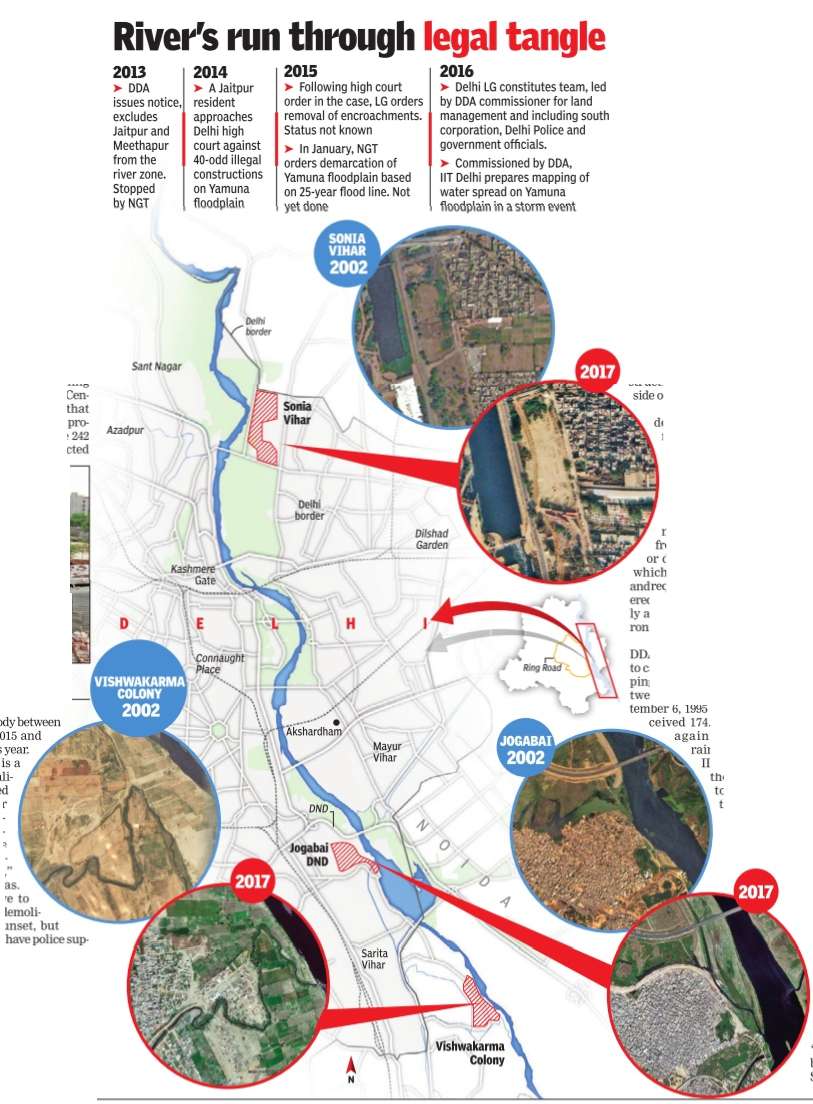
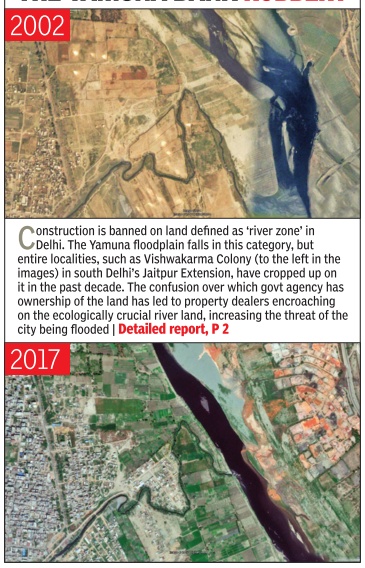
Vishwakarma Colony in south Delhi is the latest to encroach into the floodplain with property dealers taking advantage of opaque ownership rules. TOI traces the river's journey over the last 15 years to find Delhi's lifeline losing out to greed and indiscriminate urban growth
From the rooftop of Rukhsana's single storey house in Vishwakarma Col ony, you can see the Yamuna to the east. The river-facing location of the colony in south Delhi's Jaitpur Extension is one reason why Rukhsana's house should not even exist. Vishwakarma Colony falls in Delhi Development Authority's O, or river, zone, where no permanent constructions are permitted. The paradox does not end there. Despite being a no-construction zone, Vishwakarma Colony is actually expanding. As a property dealer confided, “The current “The current land price is Rs 10,000-15,000 per square yard. We sell land on power of attorney, so you will not get any other documents.“ He also claimed the cops have to be paid off.
The Jaitpur Extension colony is now among the concrete extensions into the ecologically important Yamuna floodplain that include the Commonwealth Games Village, Akshardham Mandir and Millennium Bus Depot. Hydrogeologists and scientists say Delhi is killing the river and rendering the capital vulnerable to flooding, but the official agencies tussle about who is responsible for which part of the floodplain.
The fear of floods, however, is no deterrent to encroachers.Rukhsana, who claimed to be living in Vishwakarma Colony for over a decade, and her peers have taken advantage of the lack of clarity over who owns the land in the floodplain. A spokesperson of DDA, which is the land-owning agency in the capital, told TOI, “The land in the floodplain at Jaitpur and Meethapur is private land, not development area. The South Delhi Municipal Corporation is responsible for preventing unauthorised construction.“
SDMC officials countered this by saying the primary responsibility of safeguarding the Yamuna floodplain lay with DDA.
They said that in the past year, SDMC demolished 168 properties and filed for prose cution of 186 other property owners in the Jaitpur area.
Just around 3 km from Jaitpur are Jamia Nagar and Abul Fazal Enclave, where too unauthorised construc ised construction is rampant. In the last two years, SDMC did book several property owners for unauthorised construction, but faltered in taking action. Explaining why , Mona Sreenivas, DC (Central Zone), SDMC, said that Delhi Police had provided protection for just 116 of the 242 demolition drives conducted by the civic body between January 1, 2015 and March 31 this year.
“Jaitpur is a “Jaitpur is a crowded locality and we need police to clear the neighbouring buildings before we demolish illegal structures,“ said Sreenivas.“We also have to complete the demolition before sunset, but we often don't have police support for this.“ A Delhi Police officer, while claiming security is always provided to corporation workers, retorted, “We constantly request civic bodies to inform us about demolitions a few days in advance, but we usually receive requests a few hours before a drive.“
As in 2019
Jasjeev Gandhiok, Everyone wants a piece of Yamuna, March 18, 2019: The Times of India
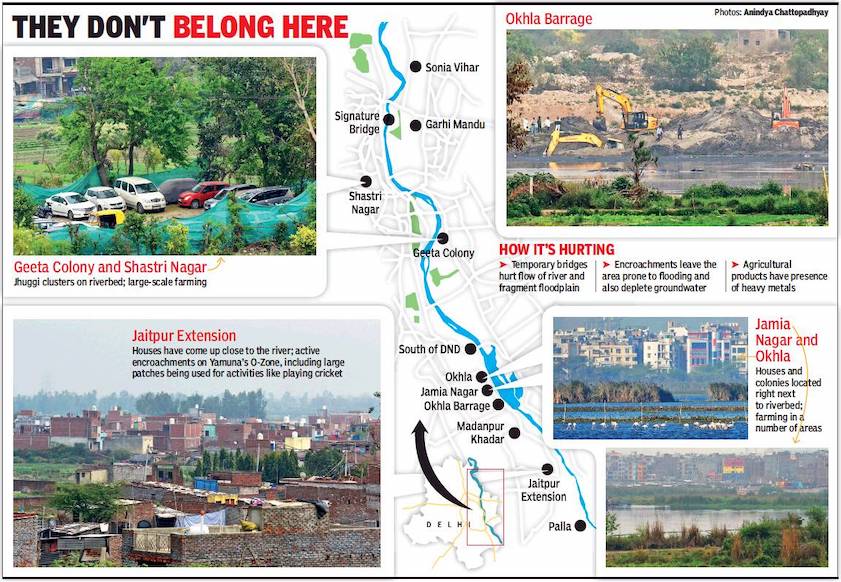
From: Jasjeev Gandhiok, Everyone wants a piece of Yamuna, March 18, 2019: The Times of India
Encroachers Inch Closer Than Ever To The River
If Delhi is serious about saving the Yamuna, it’s definitely not showing. The subject of several National Green Tribunal orders and national plans, the river continues to flow quietly through the heart of the capital, still dark and murky and emanating a pungent smell.
Key announcements made last year saw work begin on a number of sewagetreatment plants as part of the Yamuna Action Plan Phase-III, but the river faces an even bigger threat as encroachments continue to grow on the floodplain, now actively occupying the OZone (the river zone) where any kind of construction is strictly prohibited.
Wade your way through the narrow roads of Jaitpur and Madanpur Khadar in south Delhi and you will get a clear idea of the problem. It’s the tip of the iceberg, though, as numerous settlements can be seen stretching onto the river zone. Climb onto rooftops of four- and even five-storeyed houses and you will get a clear view of the river, barely 500 metres away.
On one side, a new colony seems to be mushrooming next to the river — now called Jaitpur Extension — and on the other, large-scale farming is taking place. A 2012 study by TERI had found high concentration of heavy metals, including nickel, manganese and lead, in vegetables cultivated along the Yamuna.
“The problem is not limited to Jaitpur Extension. A number of colonies are now slowly creeping into the river zone. Despite numerous court orders, very little is being done to curb this,” Manoj Misra, convener of Yamuna Jiye Abhiyan, said.
TOI visited several colonies and slum clusters along the Yamuna and the findings weren’t flattering. Rampant violations could be seen near DND, along Geeta Colony and near Okhla and Jamia Nagar too.
Misra said unauthorised colonies continued to grow and come closer than ever to the river. “Sonia Vihar and Rajiv Nagar in north Delhi are prime examples. A lot of encroachment is taking place along Wazirabad and Palla belt too. NGT has banned farming along Yamuna, but it continues unabated. Land sharks rake in the benefits as more and more houses keep coming up,” he said.
Residents, however, seem unaware of the problem. “We have always lived here and we cause no harm to the river. Farming provides us a livelihood,” Kanta Devi, a resident of Jaitpur Extension, said.
A monitoring committee appointed by NGT to rejuvenate the river stated in a recent report that encroachments in the form of pseudobridges, barrages and roads were a threat to Yamuna’s flow. The report also raised concerns over dumping of debris, groundwater extraction, illegal construction and dairy farming on the floodplain.
“Almost the entire floodplain, between the western embankment and the river channel, is under cultivation, using groundwater. It was also observed that there are a series of tubewells and ranney wells (numbering more than a hundred) owned by DJB at close intervals along the shanks,” the committee stated.
“Unorganised activity, such as dairy farming, is being carried out under the culvert below the Mayur Vihar stretch of DND. This was meant for floodwater’s spread and flow. Water on both sides of the flyway is infested with hyacinth and other aquatic/ terrestrial weed. This is possibly because of local pollution from a large number of cattle as well as polluted water coming from the Hindon cut,” the report added.
The Delhi Development Authority, tasked with reclaiming encroached-upon land on the floodplain, claims to have taken “strong” measures over the last few years.
“There is a task force in place, with quick reaction teams, to check any illegal construction or encroachment in the O-Zone,” a senior DDA official said. “DDA has installed cameras on floodplain to check any illegal construction and our security personnel keep an eye on encroachments. In fact, in the last one month, we have recruited 200 more security men for the task force,” he said.
When told about encroachments along the river, the official claimed many people were taking advantage of the election code of conduct to squat on public land or floodplain. “We are not supposed to demolish any illegal construction during this period as it might lead to change in someone’s address. However, we will check if there is any fresh encroachment on the floodplain,” he said.
Illegal temples, structures on the floodplain
Anuja Jaiswal, Oct 31, 2019: The Times of India
All “unauthorised” structures on the Yamuna floodplain, including makeshift temples situated there, should be demolished for the revival of Vrindavan’s historic ghats and beautification of Yamuna riverfronts, suggested noted environmentalist and professor emeritus in Delhi University, C R Babu, apart from making several other recommendations.
In a proposed action plan report recently submitted to the Union ministry of housing and urban affairs, Babu has also suggested that all the solid waste dumps, sewer pipes and plastic dumps should be removed from the floodplain. Babu was requested by the ministry to suggest how to bring Yamuna to the Vrindavan ghats, and to prepare an action plan for revival of the 400-500-year-old ghats and beautification of the riverfront under the Heritage City Development and Augmentation Yojana. Babu also said that sewage must be tapped before it passes through the floodplain and should be treated by constructing wetlands.
He said that as per the NGT’s orders, the municipal commissioner of Mathura-Vrindavan should initiate demarcation of the floodplain and start imposing fines for dumping solid waste and puja waste.
Set up renovated ghats, says expert
Prof C R Babu visited the entire stretch of the Yamuna that passes along the bathing ghats on August 14 this year, along with Braj Foundation officials and the municipal corporation’s chief engineer and his team members, and then submitted a report.
For the revival of Vrindavan’s ancient ghats, Prof Babu also recommended “removal of encroachment on the filled-up channel and its desilting to ensure flow of water to old bathing ghats”. He also recommended that to set up renovated ghats for immediate use, a culvert with a regulator can be made across the bund on the upstream of ghats and the water from the river channel can be drawn through another drainage pipe of one-metre diameter. This, he said, would allow the water into the river channel through a culvert across the road at the downstream of the ghats.
His also recommended that effluents from Kosi industrial town should be treated before being discharged into the river. In January this year, the NGT directed the UP government to remove all construction material from the Yamuna riverbed in Vrindavan and debarred it from carrying out any further work without its approval.
Environmentalist C R Babu also recommended that effluents from Kosi industrial town should be treated before being discharged into the Yamuna
2020/ 960ha encroached upon
Almost 960 hectares of Yamuna’s floodplain is currently encroached on and needs to be secured by the Delhi Development Authority (DDA), the final report by the Yamuna monitoring committee to National Green Tribunal (NGT) has stated.
The tenure of the committee, which was formed by NGT to oversee the rejuvenation of the river, got over on June 29. Its final report stated that an area of 954.2 hectares was encroached on or in agricultural use, while another 5.3 hectares was currently under litigation.
The report added that the Millennium Park bus depot, which has been under the Supreme Court and NGT’s scanner, is indeed a part of the river’s “O” zone where construction and commercial activity is prohibited.
From 2018 till September 2019, DDA cleared 352.3 hectares from encroachment, but a larger tract was yet to be reclaimed. Another 279.2 hectares was, meanwhile, transferred to the forest department for plantation purposes. “A considerable portion of the reclaimed land is related to 10 projects being undertaken by DDA. While this has been achieved, a much larger tract remains to be reclaimed,” said the report. “DDA has stated the encroached area is proposed to be vacated when the implementation of the projects starts, as has been done previously. The committee feels this is only a means of parrying what was directed to be done by NGT.”
No deterrent to encroachers: Panel
With delays in project execution, which DDA itself has referred to repeatedly, and non-availability of labour, the timelines for commencement of all projects and their completion appear to be quite elastic. To allow private agriculturists to continue to use publicly owned land doesn’t appear to be defensible,” the report added.
Talking about the Millennium Park bus depot, the report said, “There is no convincing documentation or other kinds of evidence advanced by DDA or DTC to show that this is not an integral part of the floodplain. The argument made that no other land was available is not acceptable. The pressure being mounted to support change of land use seems to rest on tenuous arguments and mere references of meetings, minutes and affidavits. They are not enough to make the committee conclude that the land is outside the “O” zone of the floodplain or that its use as a bus depot is an urgent necessity because of the impending arrival of new buses in 2021 and 2022.”
The committee also observed that much of the demarcation of the floodplain only existed on blueprints and maps, but there were no physical landmarks on the ground that could act as a deterrent to encroachers. “The occasional signage boards that had been erected were mostly dilapidated and rusted at most places. They were not acting as a deterrent to prevent encroachment or pollution and the fact that violation would lead to no punitive action was widely known,” stated the report.
It added that 591 bollards made of cement had been erected on the floodplain, while a tender for installing signage had also been awarded.
“The whole exercise of demarcating the floodplain with boundary pillars would be rendered futile if DDA doesn’t reclaim the land. NGT may consider giving the new vice-chairman three months to review the status of all pockets of land that are not under litigation and prepare a detailed action plan to retrieve the land and to either hand it to the forest department or take up plantation,” said the committee.
2024/ 75% of Yamuna floodplain is encroached upon: DDA
Atul Mathur, Aug 30, 2024: The Times of India
New Delhi : Of more than 9,700 hectares of the Yamuna floodplains in Delhi, nearly 75% has been encroached upon. Though Delhi Development Authority (DDA) has carried out several anti-encroachment drives, it has managed to reclaim just a little over 400 hectares in the last two years.
DDA data submitted to various agencies shows 7,362 hectare of the floodplains — categorised as Zone O in the Delhi Master Plan 2021 — bear the brunt of illegal occupation and construction.
The data emerged following a survey conducted by DDA, using satellite imaging and drone photographs, on the direction of the Delhi high court. A senior Delhi govt offi- cial said that following the directions of the high-level committee, DDA also conducted ground-truthing of geo-spatial maps of the Yamuna floodplains to ascertain the extent of encroachment.
Under Master Plan 2021, Zone O comprises the entire floodplain along the 22kmlong stretch of the Yamuna falling in Delhi — from Wazirabad to Palla — spread over 9,700 hectares. In the draft Master Plan 2041, DDA has divided Zone O into Zone O-I and Zone O-II. While no construction will be permitted in Zone O-I, the ‘river zone’, regulated development will be allowed in Zone O-II. There are around 76 unauthorised colonies in Zone O-II, which DDA has proposed to delineate to regularise the construction activities.
HC has already asked DDA to fence floodplain
The floodplain is a crucial part of the river’s ecosystem and important for recharging groundwater.
Officials said there are at least four separate cases going on in the high court and Supreme Court related to encroachment and illegal construction on the floodplain. The high court issued directions to DDA in July this year to fence the Yamuna floodplain after removing all encroachments and illegal constructions on the river bank and its river bed, as well as drains flowing into the river, to ensure no illegal construction takes place in the future. The court directed the authorities to employ the latest technologies to monitor any upcoming illegal construction.
It also directed DDA to coordinate with all agencies concerned for the removal of illegal occupants, with Delhi police to ensure maintenance of law and order during such anti-encroachment drives.
In a report to the National Green Tribunal (NGT) on July 13, DDA said it had removed encroachments from 401.4 hectare of land on the Yamuna floodplains since June 2022 by demolishing illegal structures. These included six dairy farms and three cricket grounds. DDA also cleared 10 locations of around 3,906 illegal establishments that included jhuggis, cultivated fields, and dairies.
DDA also said of the 10 biodiversity parks being developed in the Yamuna floodplain, four were encroachment-free while the remaining projects had land that has been encroached on, including land under litigation.
Floods in the Yamuna
1978-2013, 2018, Aug 2019
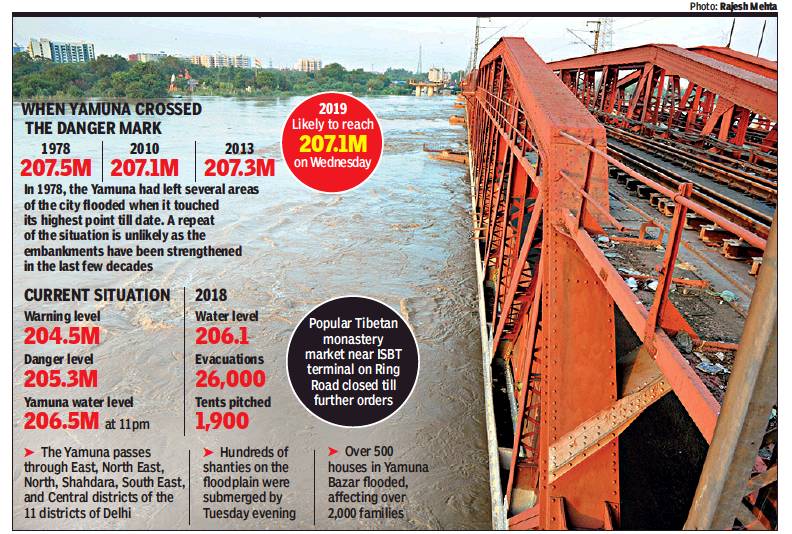
As on Aug 20, 2019
From: AlokKNMishra, August 21, 2019: The Times of India
See graphic:
Floods in the Yamuna, 1978-2013, 2018
As on Aug 20, 2019
1980-2014: Yamuna floodplains
The Times of India, March 28, 2016
Jayashree Nandi
With land regulation along the Yamuna remaining lax, there is danger ahead. Not only is the river being constricted, but the floodplains itself has narrowed drastically between 1980 and 2014 - leading to fears that there can be massive flooding in Delhi in the coming years.
The signs are already there. In recent monsoon seasons, many areas in southeast Delhi have seen basements of buildings getting submerged under water.
A recent study by IIT Kanpur and Delhi University published maps that showed how the Yamuna's floodplains has narrowed drastically in three and half decades. The fear is that in the absence of an unambiguous policy to protect the floodplains, more river zone land will be diverted for construction, compounding the problem.
"The topographic and satellite maps of Delhi from 1980 to 2014 indicate temporal variation in channel geometry and the position of river Yamuna ... it is observable that after 1980 the remaining floodplain areas were rapidly occupied by settlements, civic structures, roads, bridges, flyovers, playgrounds and metro stations," said a study published in 2014 in the International Journal of Research in Engineering and Technology. It concludes that identifying and "delineating" features such as older and active floodplains, paleo-channels and meandering channels are essential for hydrogeological evaluation.
Afzal Khan, assistant professor at Shimla University and co-author of the study, said that the considerable impact of the encroachment on the Yamuna's channels has to be studied more thoroughly. The narrowing of the riverine plains has taken place despite the regulations provided for under Delhi Development Authority's "O" zone that disallow any permanent constructions and despite the Central Ground Water Authority having declared the Yamuna floodplains a "recharge zone". Shashi Shekhar, head of the National Green Tribunal's Principal Committee on Yamuna and secretary of the ministry of water resources, said the panel was aware of the river's constriction, but explained there were no laws at the moment to protect against encroachments. "The land belongs to three agencies - DDA, Delhi irrigation department and UP irrigation department - which adds to the problem," said Shekhar.
The flow in the Yamuna ranges from 3,500 cusecs between December and February to as much as 8 lakh cusecs for a few days after the monsoon rains. According to experts, the much awaited notification of the River Regulation Zone drafted in 2002 could help regulate or prohibit activities on specified stretches of the river on both sides of the natural levee. The draft notification did go to the law ministry, but hasn't moved forward after it came back to the ministry of environment and forests.
The National Water Mission under the National Action Plan on Climate Change has also recommended zoning og floodplains to avoid climate change induced disasters. "We know that Germany and England and other countries have started to gradually remove dykes and embankments to be better prepared for floods," said Shekhar.
Contradicting the common belief that the Yamuna floodplains is fallow land that is much required by land-starved Delhi, Shashank Shekhar, professor at the department of earth sciences in Delhi University, said, "That is not so - the floodplains is the most important water reservoir for the city in times of crisis." He is worried about the encroachments that are visible in the bund road along Jaitpur and Sarai Kale Khan.
He believed that the sudden flooding of basements in areas such as Okhla, Sukhdev Vihar and Lakshmi Nagar in recent years have been caused by "lack in connectivity of the floodplains to its catchment or its basin due of encroachments".
The Yamuna: The highest flood levels recorded
Floods in Delhi
The Yamuna, which has been reduced to being just a drain, transforms during the rains into a raging, menacing river
208.66 metres 2023 | 13 July
207. 95 metres 2023 | 12 July
The Yamuna, which has been in spate for the past two days and had crossed the danger mark, rose to its highest level on record and began to submerge low-lying areas on Wednesday. The river was flowing at 207. 95 metres at 9pm
As the water gushed into low-lying areas, colonies and markets, the authorities evacuated 16,564 people. About 14,534 of these took refuge in tents pitched by the Delhi government and under flyovers.
Late in the evening, officials had to conduct a rescue operation at Vishwakarma Colony. At night, a section of Bhairon Marg got flooded trapping a DTC bus.
All flyovers in the Delhi section of Noida-Link Road and service lanes till ITO were full of people and their cattle.
207.49m 1978 |5 Sept
The Yamuna touched 207.49m on September 5 after 7 lakh cusec water was released upstream. Large parts of west, north and east Delhi, including Shalimar Bagh, Model Town and Mukherjee Nagar, were under 4-5 feet of water. It remains Delhi’s worst flood to date
207.32m 2013
8 lakh cusecs of water were released in the river in 2013.
207.11 m 2010 | Sept
Towards the end of September, the Yamuna rose to 207.11m and stayed at that level for eight hours. Areas like Kashmere Gate, Batla House, parts of Ring Road, Jaitpur and Majnu Ka Tila were flooded. Back flow from sewers submerged hundreds of houses in low areas
206.93 m 1995 | Sept
In Sept, river touched 206.93m. While release from Tajewala was massive, Delhi didn't let out water from Okhla barrage fast enough. Around 15,000 families lived in temporary shelters on main road for two months
206.92 m 1988 |21 Sept
Continuous torrential rain in the hills from September 21 raised the Yamuna’s level to 206.92m at the Old Railway Bridge. Many areas in east and north Delhi, including Mukherjee Nagar, Geeta Colony, Yamuna Bazaar and Red Fort were affected
206.6m 2019
8.28 lakh cusecs of water were discharged into the river
Do floods help the Yamuna?
2013/06/22
Swell in Yamuna kills the stink
If you thought the Delhi stretch of Yamuna had long become a sewage pool, visit the river now. Flooded to the brim, it is reminiscent of what Yamuna may have originally looked like. The flood may have played havoc by displacing communities but it has also managed to dilute the polluted water and enliven a dead river.
Towards Okhla (downstream) the river water usually has a biochemical oxygen demand of 40 to 50 mg/l but since June 15, the BOD measured less than10 mg/l according to Central Pollution Control Board.
BOD is an important determinant to show how polluted the river water is. It is a measure of the quantity of oxygen used by microorganisms in the oxidation of organic matter. The acceptable limit of BOD is 3 mg/l.
“The pollutants have been washed away but the water is very turbid because of the debris that has come with the floodwater and runoff from agricultural fields. Even after the water level recedes, there will still be surplus water and we expect that pollution levels will be low for about two months,” said a senior officer from CPCB.
The flooding will also have an impact on the groundwater say scientists. Saumitra Mukherjee, professor of geology and remote sensing, School of Environmental Sciences, Jawaharlal Nehru University, says that there are lots of negative effects of flooding but one of the positive impact is the improvement in soil quality. “The flood brings with it fine silt, clay and sand. These and the sediment formed from them are usually fertile and can be beneficial for agricultural purposes. The floodwater also helps recharge underground aquifers,” he says.
However, he warns that the floodwater loaded with fecal matter can contaminate both the surface water and groundwater. “There has to be intensive monitoring of the water quality to check if it can cause contamination. When the floodwater starts receding there is a high chance of an epidemic and spread of bacterial infection among communities living by the river,” he adds.
The flooding also impacts aquatic life. The dead river may now have enough water to create the environmental conditions for spawning of certain species of fish.
“Floods are very important for Yamuna in Delhi. Earlier we had a lot of wetlands but development has eaten in to those. Usually during floods when the floodwater recedes, these pools or wetlands are recharged. Even our floodplains have been encroached upon. We need forests and grasslands by the river to retain and use the floodwater. We need a river front forest ecosystem,” adds Faiyaz A Khudsar, scientist at Yamuna Biodiversity Park
Floods rejuvenate river
Soil and water quality in Yamuna likely to remain slightly better for a couple of months from now Contaminated floodwater can also pollute groundwater. There are high chances of an epidemic as water recedes
Floodwater loaded with fine silt, clay and sand is likely to make the Yamuna soil fertile and will be benefi cial for agriculture
Floodwater will help recharge underground aquifers
It will rejuvenate wetlands near Yamuna
Flooding can induce breeding or spawning in some fish species in Yamuna
Flooding has already diluted polluted water near Okhla
Flooding can be alarming for some species like snakes and insects, which have started coming out of the burrows
River corridor vegetation and agriculture in floodplains likely to improve after fl oodwater recedes
They clean up the river
Jasjeev Gandhiok, August 25, 2019: The Times of India
Sudden rise in the water level of Yamuna wreaks havoc on people living in the floodplains almost every year. Thousands get evacuated every time the water level soars to an alarming level. But flood is essential not just to keep the river alive through the year, but also to recharge the sub-soil aquifers along the floodplains, say experts.
With more water getting released through the Hathni Kund barrage — the Yamuna at present could be at its cleanest point this year. A significant improvement in the dissolved oxygen (DO) and biological oxygen demand (BOD) has been noticed over the past week.
Yamuna Jiye Abhiyan convener Manoj Mishra said that the river is thriving at present and serving an important ecological function. “During the floods, a lot of sub-soil aquifers get recharged, which helps the river sustain itself during the lean period. The water quality too has improved considerably, and the Yamuna should be at its cleanest point right now,” said Mishra.
“During the first spell of floods, water remains quite muddy. But after more water is released through the Hathni Kund barrage, the quality of water starts to improve. The flow of water allows the waterbody to have a higher dissolved oxygen count than what is normally seen through the year,” Mishra added.
Faiyaz Khudsar, scientistin-charge at the Yamuna Biodiversity Park in north Delhi, said that the flooding has rejuvenated Phase-II of the biodiversity park, which falls in the active flood zone. “The DO should be around 8-10 mg/l, while the BOD appears to be around 3-4 mg/l, which is a great sign,” said Khudsar.
According to him, waterbodies and aquifers on the floodplains are receiving crucial water during this period. “When the river is flooded, the floodplains see a lot of plant species thrive as well. This then attracts more fauna, and helps sustain an entire ecosystem. Flooding phase plays a key role in improving the groundwater table too,” added Khudsar.
The University of Chicago’s Tata Centre for Development has been monitoring the water quality of the river for two years now through sensor-based technology that provides realtime readings. Priyank Hirani, programme director of the water-to-cloud project, said that tremendous improvements were observed each time water was released from the Hathni Kund barrage. “Water is being released now in huge quantities, which is sufficient to improve all parameters,” said Hirani.
On August 18, around 8.28 lakh cusecs was released by the barrage – the highest ever, and the river had touched 206.60 metres on Wednesday. On Thursday, the river level fell below the ‘danger’ mark of 205.33 metres, and was flowing at 204.28 metres at 1 pm on Friday.
2018: highest in 5 years
Yamuna breaches 206-metre mark, highest level in 5 years, August 1, 2018: The Times of India
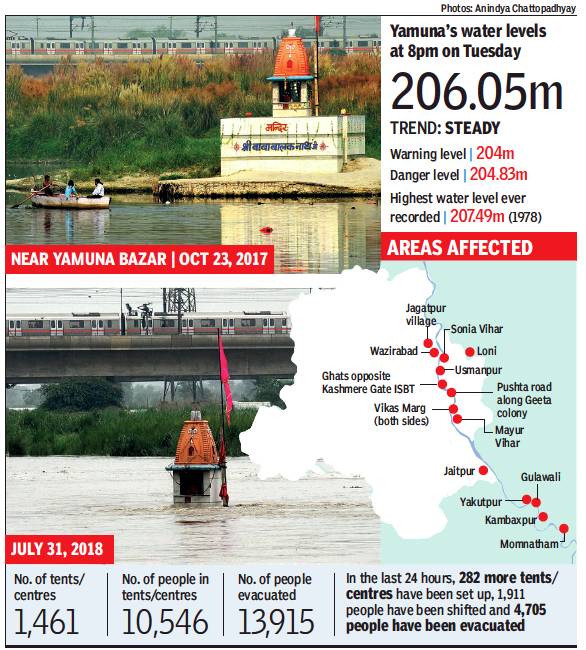
From: Yamuna breaches 206-metre mark, highest level in 5 years, August 1, 2018: The Times of India
RELIEF WORK ON; TRAIN MOVEMENT DISRUPTED ON LOHA PUL
For the fourth consecutive day, the water levels in the Yamuna continued to rise as it crossed the 206-metre mark morning — the highest in the past five years.
At 8pm, the water level was 206.05 metres as another 28,126 cusecs of water was released from Hathnikund Barrage, taking the total release to 5 lakh cusecs in four days. As several low-lying areas remain impacted, Central Water Commission classified the water levels as ‘steady’.
So far, 10,564 people have been evacuated by the Delhi government and around 1,461 tents have been set up.
Emergency services are also being provided wherever required, said officials. “The water levels reached further inwards on Tuesday. Meals are being provided three times a day and we have medical staff on the standby along with disaster management teams,” said K Mahesh, DM (east and Shahdara).
A number of ghats along Kashmere Gate ISBT got submerged with sandbags being used to stop the flow towards Ring Road since Monday. “We placed sandbags on Monday but the water level has almost reached the road in some parts. More sandbags will be used if required,” said an official. Delhi’s revenue, flood and irrigation minister, Kailash Gahlot, has taken stock of the situation after visiting some of the affected areas. Meanwhile, Old Yamuna Bridge, popularly known as Loha Pul, remained shut with the traffic being diverted towards Geeta Colony, the police said. The railway operations on it, too, were stopped in the early hours, and two passenger trains were cancelled, 19 short-terminated and 17 diverted.
The highest ever water level recorded at Old Yamuna Bridge was 207.49 metres in 1978, while it touched 207.32 metres in 2013 — the last time Delhi saw such a situation.
The Ghaziabad administration has also sounded an alert after the river water entered the floodplains in Loni, affecting agricultural activities.
Loni SDM Satendra Singh said, “Seven-eight labourers, who were keeping a watch on rose cultivation in the floodplains, have been shifted to safe places. The inhabited areas are on the opposite side of the Alipur dam in Loni, and they are safe at present. The water level receded by 10cm by the evening.” The areas adjoining Hindon river got flooded after water back-flowed into the river and breached the walls made by farmers to protect their land, said Neeraj Kumar Lamba, executive officer, irrigation department.
Gopal Rai, a resident of Nagla who shifted with his family to Panchayat Bhawan, said, “The current in the Hindon is quite strong and there are chances that water may reach our home. As a safety measure, we have shifted here. Two-three other families have also taken shelter at Panchayat Bhawan.”
In Noida, the Yamuna water entered farmlands along the 29km-long embankment on the floodplains on Tuesday. The district administration said they still didn’t need to start any relief work. However, the rising level of water has destroyed crops on hundreds of acres on the floodplains. Ali Hasan, a resident of Gulawti village, said, “I have 20 acres along the floodplains, and the crops have been ruined.”
Pollution in the Yamuna
Increasing pollution in the Yamuna
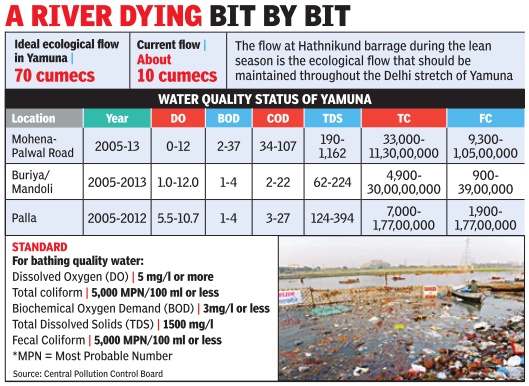
After 21 years of SC monitoring, Yamuna still stinks like a sewer
The Times of India, Jan 09 2015
Amit Anand Choudhary & Dhananjay Mahapatra
4 Lakh To 16 Crore Coliform In River Against Norm Of 5,000, CPCB Tells SC
Central Pollution Control Board told the Supreme Court why the Yamuna in its 22-km course through Delhi mostly stinks like a sewer drain as against the norm of 5,000 MPN coliform per 100 ml of water, Yamuna water in Delhi had between 4 lakh to 16 crore coliform per 100 ml. The norm of 5,000 MPN100 ml of water is the quality prescribed for `C' category of water, which is fit for drinking after treatment.But, on January 7, 2014, the total coliform in Yamuna water at Nizamuddin was 54000000 (5.4 crore) and at Kalindi Kunj it was 160000000 (16 crore). But, at Palla the river water is relatively clean. On January 7 last year the total coliform detected at Palla was 43,000.
After 21 years of intense monitoring of government efforts by the Supreme Court to clean the Yamuna, the CPCB, through advocate Vijay Panjwani, submitted to the court a detailed report on the state of pollution of river water at Pal la, Nizamuddin, Kalindi Kunj, Okhla and Madanpur Khadar in the 22-km stretch it flows through Delhi.
Despite the SC monitoring, Delhi appeared to be the biggest culprit in polluting the river. The water quality of Yamuna at Palla when it enters Delhi met the standard of “A“ grade water, which is fit for drinking without conventional treatment but after disinfection, in respect of pH level, dissolved oxygen, bio-chemical oxygen demand as well as coliform on most days except on five of the 12 testing days between November 19, 2013 and October 8, 2014.
But at the rest of the places through the city , the water did not even qualify to the standard of “C“ grade water and was declared unfit for even bathing. The CPCB also submitted the quality of water in 22 drains that joins Yamuna during its course through Delhi.
A year ago in December 2013, the Supreme Court had sought expert help from the Indian Institute of Technology (IIT) after being told by CPCB that despite Rs 5,000 crore spent for reducing pollution, the river was staring at a catastrophe as over 2,400 million litres of untreated sewage flows into it every day.
Since 1994, when the apex court took up monitoring of steps to reduce pollution in Yamuna, Uttar Pradesh has spent Rs 2,052 crore, Delhi government and its civic bodies Rs 2,387 crore and Haryana Rs 549 crore to clean the river, taking the total to Rs 4,988 crore.
A joint report by CPCB and DJB had informed the court a year ago that the situation would get worse as “waste water generation due to growth of urban population will be substantial and may be in the range of about 5,000 to 6,000 MLD respectively for the corresponding years 2021 and 2031“.
Rain not washing away toxins
Rain not washing away Yamuna toxins Jayashree Nandi The Times of India Dec 01 2014
New Delhi
Yamuna water is toxic, to say the least. But what is worse is that there seems to be a continuous discharge of industrial effluents into the Delhi stretches of Yamuna so that there is no improvement in postmonsoon months either when pollution is supposed to be far more diluted.
A recently concluded study by Toxics Link, an environmental NGO, found heavy metals like lead, chromium, arsenic and mercury to be several times the safe standard and, in some cases, even several hundred times the bathing water quality standard set by Central Pollution Control Board in preand post-monsoon months.
A team of researchers collected water samples from seven locations starting with Jagatpur village where the water appears to be marginally cleaner. The researchers travelled by boat to be able to collect water in bottles and buckets from near Najafgarh drain, Wazirabad, Majnu Ka Tila, near Vidhan Sabha drain, ISBT and Yamuna Bazar. The water samples were analysed for the most toxic heavy metals. Chromium levels were the highest with a maximum concentration of about 796.99 parts per million when the standard is 0.5ppm. The maximum level for lead was 55.7ppm when the standard is 0.1ppm.
“We couldn't find a uniform trend in preand postmonsoon levels which show that industries are constantly discharging these heavy metals leading to high toxicity levels throughout. We are also assessing whether the high chromium levels are due to tanneries discharging untreated effluents. But it's clear that a lot of industrial waste is polluting Yamuna,“ said Prashant Rajankar, programme coordinator, Toxics Link. High chromium levels are often linked to skin rashes, ulcers, weakening of the immune system, kidney and liver damage and many other health impacts.
The study was also used as an introduction for the recently concluded India Rivers Week where about 125 academics, scientists, activists from all states thrashed out the definition of a “healthy river“ and what is ailing Indian rivers. The reason for organizing such a conference is also the current government's agenda of interlinking rivers.
The 125 experts will work in four groups to arrive at a consensus on certain crucial issues related to rivers and controversial or `environmentally unsound' projects like interlinking or rivers, massive hydropower projects, dams and others. At the end of four days, experts will prepare an India rivers charter articulating the vision for saving rivers.
At IRW, experts also drew attention to a recent appraisal by Yamuna Jiye Abhiyan that has found there is no river in any of the top 50 cities (based on population) in India that is not sick or dying with river Yamuna in DelhiMathura-Agra and Ganga in Kanpur-Varanasi-Patna leading the list.
Pollution is irreversible
The Times of India, Feb 08 2015

Yamuna pollution can't be reversed: Water commission
Arvind Chauhan
The Yamuna, by the time it flows through Agra, has nearly 50 times more biochemical oxygen demand (BOD) than the permissible limit. The Central Water Commission (CWC) has declared that the river water at Agra is safe neither for irrigation nor for domestic use.Water in the river, now polluted beyond repair, an official said, is also contaminating ground water.
BOD is the amount of dissolved oxygen needed by aerobic biological organisms to break down orga nic material, in a given time and at a certain temperature. Once BOD increases beyond a certain limit, it becomes a pollutant, leading to the growth of harmful bacteria.
BOD forms when the equilibrium of chemical compounds and solid waste is disturbed in a water body .
A CWC official said, “This contamination level is irreversible. Water is unusable, both for irrigation and drinking. In fact, polluted water from the Yamuna is also partially responsible for the contamination of ground water in Agra.
Idol immersion
Chhath (and other) pujas
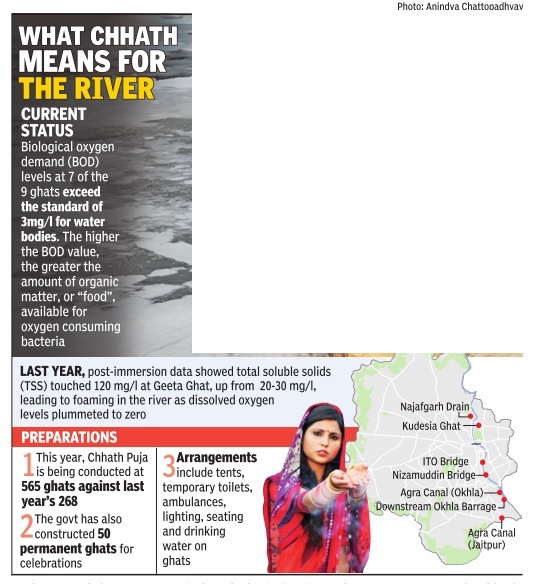
From: Jasjeev Gandhiok, Already polluted river braces for yet another onslaught, October 26, 2017: The Times of India
City ghats are all decked up for chhath puja: while extensive preparations have been made to ensure that devotees face no hardships, environmentalists are having sleepless nights over what it could mean for the already fragile river.
Immersions during Ganesh Chaturthi and Durga Puja had led to pollution levels soaring at Yamuna. The National Green Tribunal had taken civic bodies to task over semi-dissolved idols and puja material being strewn all over the banks.
As devotees prepare to enter the Yamuna to offer prayers to the Sun God, similar fears are being expressed, even as experts say that foam in the river already testifies to the poor quality of water post-immersion last month.The Delhi government has declared a holiday on the final day of the three-day festival, which sees devotees entering the water and offering `Arghya' to the setting sun.
A Delhi Pollution Control Committee official told TOI that special steps have been taken to monitor pollution levels in the river. “We have barricaded the river and arrangements have been made on the banks for the puja. The ghats will be cleaned immediately after the puja is over,“ the official said.
A report released by DPCC last year had shown an increase in biological oxygen demand (BOD) levels up to 30 mgl at several ghats, even as dissolved oxygen levels plummeted to zero. The standard BOD level for water bodies is 3mgl. DO should be 4 mgl, or higher. Yamuna's water quality is currently in the `E' category, which makes it fit only for irrigation and industrial usage.
Satish Sinha, associate director of NGO Toxics Link, said: “As it is, the water in Yamuna is very polluted. Lead and heavy metals present in the river can prove harmful, so exposure should be reduced.“
This year, the government has earmarked 565 ghats for chhath puja against 268 last year. It has also constructed 50 permanent ghats for the celebrations.
Surat vis-à-vis Delhi
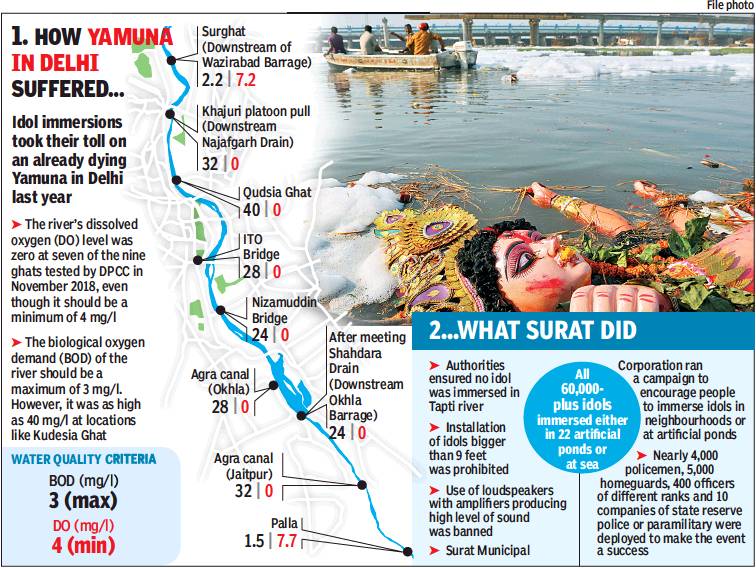
From: Ritam Halder, If Surat can do it, so can you: NGT tells govt to take lessons on idol immersion, January 28, 2019: The Times of India
In 2018, Tapti Kept Free Of Chemicals
A monitoring committee appointed by the National Green Tribunal has directed that a Delhi government official visit Surat and learn how to effectively manage idol immersions by ensuring no harmful chemicals or items are dumped into the Yamuna.
In a report submitted to NGT, the two-member monitoring committee, which includes retired expert member BS Sajwan and former Delhi chief secretary Shailaja Chandra, expressed concern over the toxic water post-immersion in the Yamuna and asked Delhi to follow the Tapti example, where the administration ensured that no idol was immersed in the 2018 festive season.
“The time from January until March should be used to plan effective management with the goal of controlling toxicity in the river... The divisional commissioner may consider visiting Surat along with the relevant police special or joint commissioner to get a first-hand idea of how things were managed there,” the committee has written to the Delhi government.
Authorities in Surat ensured that no idol was immersed in the Tapti river. All 60,000-plus idols were immersed either in 22 artificial ponds or at sea. According to experts, steps taken by the city administration of Surat, Ahmedabad and Rajkot should be studied to understand how the Ganapati immersion was managed there.
“Delhi needs to create sufficient artificial ponds before issuing a notification that only designated ponds will be permitted. Instead of banning things, people should be made aware of the health hazards of high levels of heavy metal and faecal coliform that take place post-immersion to justify preventive steps, which the public should understand is for their protection,” it said.
In 2018, after idol immersion of Durga Puja and Ganesh Chaturthi, organic pollution such as Biochemical Oxygen Demand (BOD) increased due to human influence and puja ingredients. Concentration of heavy metals increased in the river due to immersion of painted or polished idols with metallic ornaments and shiny materials, a Central Pollution Control Board report stated.
After Durga Puja immersion, chromium increased from the Bureau of India Standards limit (0.05 mg/l) by 11 times; iron concentration increased from BIS limit (0.3 mg/l) by 71 times; and lead increased from BIS limit (0.01 mg/l) by two times in the Yamuna.
After Ganesh Chaturthi immersion, arsenic increased from the BIS limit (0.01mg/l) by 3 times; chromium increased by 2.8 times; copper concentration increased from BIS limit (0.05 mg/l) by 1.6 times; iron concentration increased by 331 times; lead increased to 25 times; nickel increased from BIS limit (0.02 mg/l) to 4 times and mercury increased from BIS limit (0.001 mg/l) by 0.6 times in the Delhi stretch of the river.
2018> 2019: an improvement
Jasjeev Gandhiok , Oct 12, 2019: The Times of India
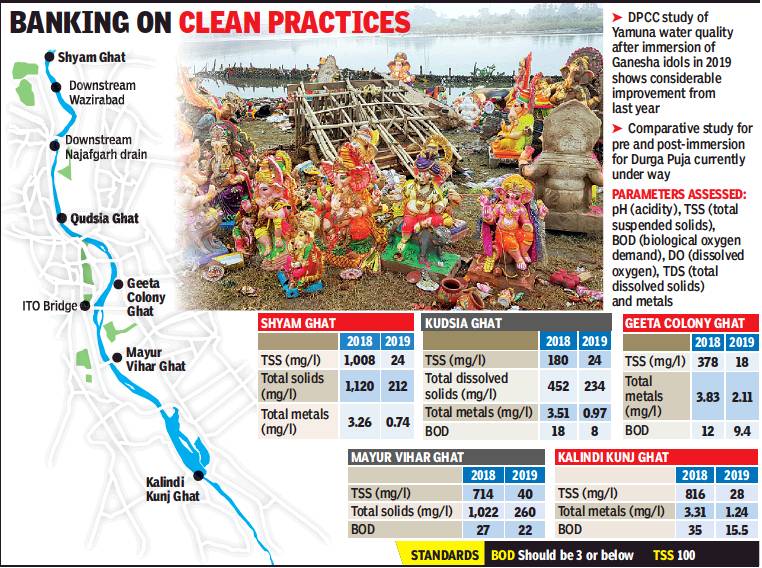
From: Jasjeev Gandhiok , Oct 12, 2019: The Times of India
After the ban on immersion of idols in the Yamuna to prevent pollution by heavy metals and toxic dyes, Ganesh Chaturthi in September was the first time devotees in Delhi consigned clay statues of the elephantheaded god to water in specially created ponds instead of the river. If the data gathered by Delhi Pollution Control Committee (DPCC) post-immersion in 2018 and 2019 is an indication, the river water saw a significant reduction in pollution levels. DPCC says this is a strong signal that banning idol immersion in the Yamuna can be effective in preventing contamination of the river. The panel is currently assessing the water quality post-Durga Puja.
The Ganesh Chaturthi data that TOI has accessed shows a reduction across almost all parameters, among them presence of heavy metals, total dissolved solids and biological oxygen demand, which measures whether aquatic life can survive in the water. “With no immersion of idols, the total dissolved solids, total soluble solids, total solids and heavy metal have gone down significantly,” Arun Mishra, member-secretary, DPCC, told TOI. “Because no toxic dyes and paints entered the water, there has been an improvement in the biological and chemical oxygen demands.”
DPCC compared data gathered from 10 ghats for 2018 and 2019 and found improved water quality at all locations. The water quality is determined by analysing parameters such as acidity, suspended and dissolved solids, dissolved oxygen and the presence of copper, nickel, iron, cadmium, lead, zinc and other metals. At Shyam Ghat, the total soluble solids (TSS) decreased from 1008 mg/l last year to just 24 mg/l this year, while the total metals came down from 3.26 mg/l to 0.74 mg/l. At Sur Ghat, TSS levels went down substantially from 878 mg/l in 2019 to 22 this year. The total metals came down to 4.6 mg/l this year against 12 last year, while at Qudsia Ghat TSS fell from 180 mg/l last year to 24 in 2019.
As for the biological oxygen demand — a level of 3 mg/l and below sustains aquatic life — the improvement this year was remarkable. At Ram Ghat, it feel from 6 mg/l to 4.8 mg/l, at Sur Ghat from 12 mg/l to 4.6, at Kali Ghat from 20 mg/l to 6.2, and at Qudsia Ghat from 18 mg/l to 8. The drop was highest at Kalindi Kunj — from 35 mg/l to 15.5.
“The drop in the parameters shows the impact that stopping immersion of idols can have on the Yamuna,” said Mishra. However, Manoj Mishra, convener of Yamuna Jiye Abhiyan, said the ban on immersions should be seen only as a first step. “Idol immersion is a seasonal occurrence, so a lot more needs to be done to control effluents and other contaminants being discharged into the Yamuna,” said Mishra.
Delhi, Panipat, Sonepat are the main polluters
Jayashree Nandi, Delhi equally to blame for dirty Yamuna, February 28, 2018: The Times of India
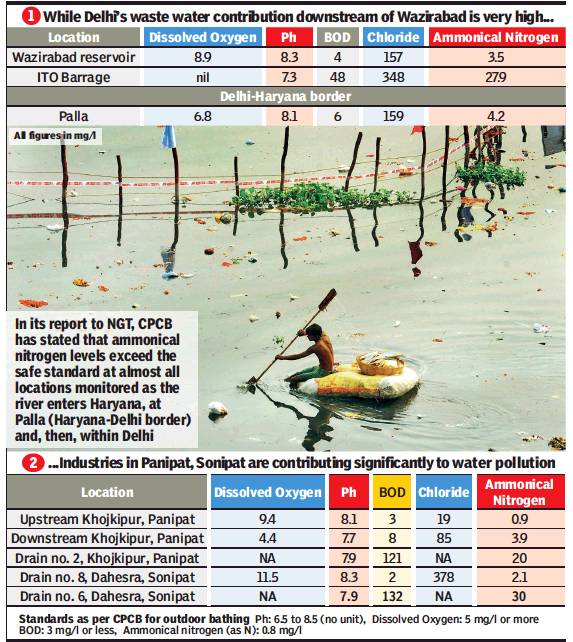
From: Jayashree Nandi, Delhi equally to blame for dirty Yamuna, February 28, 2018: The Times of India
A Central Pollution Control Board report submitted to the National Green Tribunal has found the levels of ammoniacal nitrogen (as N) exceeds the safe standard at almost all locations monitored as the river passes through Haryana, Palla (Haryana-Delhi border) and then within the Delhi stretch.
Ammonaical nitrogen is basically a measure for ammonia, a pollutant often found in waste water, fertiliser run off or industrial effluents. It is known to reduce the effectiveness of water treatment technologies.
The report submitted by CPCB on Tuesday indicates that the ammoniacal nitrogen level upstream of Khojkipur in Panipat is 0.9 mg/l, while the safe standard is 0.8 mg/l. As the river passes through other drains in Haryana, levels go up significantly, testing at 30 mg/l at drain no. 6, Dahesra, Sonepat. At Palla border it improves to 4.2 mg/l, still above the safe limit even after treatment for drinking water supply to Delhi. At ITO barrage with Delhi’s untreated waste water also adding to Yamuna water, ammoniacal nitrogen level rises to 27.9 mg/l.
The report which has test results from samples collected on February 23, 2018, shows that industries in Panipat and Sonepat may be contributing significantly to Yamuna water pollution but even Delhi’s waste water contribution downstream of Wazirabad is very high and may be impacting water used from Agra canal for irrigation purposes.
Overall, the report indicates the water is at its best quality before drains in Panipat and Sonepat start polluting it.
Dissolved oxygen (DO) levels were also found to be nil at ITO barrage, indicating that the river in Delhi is nearly dead. DO is necessary for the survival of many forms of life including fish, invertebrates and aquatic plants. The Ph levels are complying with standards at all locations. The Biochemical Oxygen Demand (BOD) (the amount of DO needed by microorganisms in various biological processes) at most locations, even in Haryana, exceeds the standard.
“The primary cause for high ammonia levels is industries in Panipat and Sonepat discharging effluents and polluting water bodies. It’s a recurring problem. Water with high ammonia is not potable, treatment processes cannot also bring to acceptable limits. However, when Delhi says Haryana is not taking care of treating the water that’s coming to Delhi, it should also look at what the capital is releasing downstream,” said Manoj Misra of Yamuna Jiye Abhiyan.
According to WHO, high ammonia levels are an important indicator of faecal pollution. “Taste and odour problems as well as decreased efficiency in disinfection are to be expected if drinking water with more than 0.2 mg of ammonia per litre is chlorinated.”
Shashank Shekhar, assistant professor in the department of Geology, Delhi University, said that when water with high levels of ammonia is treated in a plant which uses chlorination to treat water, there is a chemical reaction which forms chloramine. Chloramine has various health impacts, which is why water polluted with ammonia cannot go through chlorination.
According to Chloramine-.org , people with liver or kidney disease and those with hereditary urea cycle disorders are at increased risk for ammonia toxicity from the consumption of chloraminated water. Chloramine cannot kill the pathogens in the water as well as chlorine. As a result, people with suppressed immune systems must have their water boiled over 10 minutes before use to kill pathogens, or they risk becoming ill.
Is Delhi to blame for dead fish in Vrindavan?
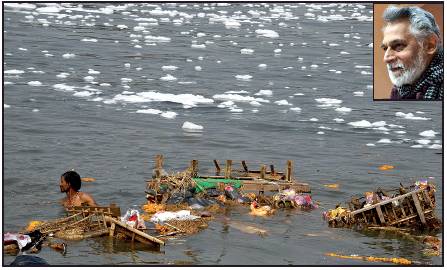
From: Ritam Halder, Far-fetched: Why Delhi can’t take blame for dead fish in Vrindavan, November 5, 2018: The Times of India
Toxicity Level Goes Down By The Time Water Reaches UP, Say Experts
The Yamuna may be heavily-polluted in Delhi, but experts said that it can’t impact fish in Vrindavan. Manoj Misra, convener of Yamuna Jiye Abhiyaan, told TOI that by the time the water reaches Vrindavan and Mathura in Uttar Pradesh, the toxicity level goes down.
“The water released in Delhi is no doubt filthy, but it won’t be right to say it kills the fish in Vrindavan. The reason for this can be attributed to local factors like industries dumping effluent or the water that flows down Kosi drain,” Misra said.
Earlier, officials of Uttar Pradesh Pollution Control Board (UPPCB) in Mathura had claimed that thousands of fish and other aquatic animals were found dead in Yamuna in Vrindavan following discharge of 3,000 cusecs of “highly-polluted” water from Okhla barrage on October 28.
Himanshu Thakkar, a social activist at South Asian Network on Dams, Rivers and People, echoed Misra’s views and said it was unlikely that Delhi’s dirty water was killing the aquatic populace at Vrindavan.
“The distance and time are definite factors here. Essentially, fish die because of less oxygen or toxicity due to chemicals. In either case, the impact should be seen much earlier. The deaths may have occurred due to local sources,” Thakkar said.
Despite decades of planning and thousands of crores being spent on its clean-up, Yamuna continues to be a dead river, especially after it enters Delhi near Palla and covers a distance of about 48km. The 22-km stretch from Wazirabad to Okhla is only 2% of the river’s length, but 70% of the total pollution gets loaded here as 22 drains flow directly into it. Of these, four main drains — Najafgarh, Najafgarh supplementary, Shahdara and Barapullah — are the key contributors to pollution.
At present, as part of Yamuna Action Plan-III, an initiative under the Centre’s Namami Gange programme, an estimated Rs 1,656 crore have been approved to construct eight sewage treatment-related projects in Okhla, Kondli and Rithala, among others.
Delhi Jal Board vice-chairperson Dinesh Mohania said work is going on as planned. “The tendering process has started for the Okhla plant. The water quality in Yamuna is foul largely because of the untreated water coming in from Najafgarh and other drains,” he added.
However, in a city where most households don’t have sewage connections, most of the waste ends up in the river. On paper, there are 50-60% connections as part of Delhi’s sewage network, but in reality it is around 20% as there are very few people who have taken sewer connections.
2% of Yamuna responsible for 76% of its ills
December 10, 2018: The Times of India
A small stretch of less than 2% of the Yamuna accounts for 76% of the river’s pollution, according to a monitoring committee overseeing its cleaning.
The committee has further said that the river is “fighting to stay alive” and it would not be possible to rejuvenate the Yamuna unless minimum environmental flow is provided as it is “virtually reduced to a trickle and remains dry in some stretches for almost nine months of the year”.
National Green Tribunal Chairperson Justice A K Goel had in July formed the monitoring committee comprising retired expert member B S Sajwan and former Delhi chief secretary Shailaja Chandra and directed them to the submit an action plan and detailed report on cleaning of the river by December 31.
The committee has submitted the details to the Delhi government.
In the action plan, it is mentioned that “Although the Yamuna river flows only for 54 kilometres from Palla to Badarpur through Delhi, the 22 kilometre stretch from Wazirabad to Okhla, which is less than 2% of the river length of 1370 kilometres from Yamunotri to Allahabad, accounts for about 76% of the pollution in the river”. This 2% stretch from Wazirabad to Okhla sees maximum discharge of untreated industrial and domestic wastes.
The committee has suggested that a team of scientists be formed from CPCB, DPCC and other institutions like IIT Delhi or NEERI to carry out inspections and submit reports to it for remedial action. The team can look into the risks and benefits of an alternative way of routing the same quantity of water which can help in reducing the pollution level, it said.
The committee has also recommended a mechanism to be worked out jointly with DPCC and CPCB to install an online system for quality testing of water in Yamuna at Palla and Wazirabad.
“Not only standard parameters would be included but also ammonia because this is brought up as a recurrent problem which impacts drinking water supply to Delhi,” it said.
The monitoring committee also raised objection to the capacity utilisation of common effluent treatment plant (CETP) which is as low as 25%.
Another area of concern is the direct discharge of completely unregulated waste from industries and residences into the river.
“The industrial pollutants when mixed with domestic sewage are not amendable to treatment even by the STPs due to limitation of treatment technology,” the committee ruled.
In 2020 as well
Jasjeev Gandhiok, January 16, 2021: The Times of India
2% of Yamuna in Delhi to blame for 76% of pollution
New Delhi:
The water quality at Palla, where the Yamuna enters Delhi, differs considerably from the last ghat at Agra canal in Jaitpur.
By the time the river reaches Khajoori Paltoon Pool, the third ghat downstream at which Delhi Pollution Control Committee (DPCC) measures readings, the water quality is already beyond the permissible limits for both biological oxygen demand (BOD) and dissolved oxygen (DO) levels.
The last readings collected by DPCC on December 30, 2020, showed six out of nine ghats had a DO level of 9 mg/l, whereas it should be 5 mg/l or higher to sustain aquatic life. Similarly, BOD levels, which should not be above 3 mg/l, were found to be as high as 70 mg/l at the point where the Shahdara drain meets the Yamuna, indicating the impact of considerable sewage entering the river.
While high ammonia has remained a concern over the past two months, disrupting the water supply, the river’s water quality has remained toxic, deteriorating even with no immersion taking place. While Supreme Court took suo motu cognisance of the pollution levels on Wednesday and issued notices to five states, including Delhi, as well as Central Pollution Control Board (CPCB), little seems to be changing on the ground.
Delhi accounts for a major chunk of the pollution in the river, largely owing to untreated sewage directly entering it. The process to tap all colonies and connect them to sewage treatment plants (STP) may still take over two years, even by agency timelines.
According to the National Green Tribunal-appointed Yamuna Monitoring Committee, a stretch in Delhi that accounts for less than 2% of the river contributes to 76% of the total pollution. The committee had also recommended that NGT ask both DPCC and CPCB to analyse and share reports each month of the water quality. Manoj Mishra, convener of Yamuna Jiye Abhiyaan, said while Haryana could be blamed for the high ammonia levels, the pollution in the river was all Delhi’s doing. “We have seen timelines and goalposts shift each year and we are yet to see Delhi’s drains trapped and connected to STPs. Until that is done, there will be no improvement. However, it seems unlikely that even the new timelines will be adhered to,” he added.
DPCC’s data showed while the Yamuna stayed relatively clean at Palla as well as Surghat, water quality deteriorates by the time it reaches Khajoori Paltoon Pool, which falls downstream of the Najafgarh drain. While DO readings were 7.4 mg/l at Surghat and 7.9 mg/l at Palla, they plummeted to zero at Khajoori and remained zero through the remaining course of the river in Delhi, barring Nizamuddin bridge, where a reading of 0.7 mg/l was recorded. The BOD readings were 1.2 mg/l and 2.6 mg/l at Palla and Surghat, respectively, spiking to 38 mg/l at Khajoori.
Incidentally, a spike in BOD concentration was seen after wastewater was introduced in the river through nearby drains. While the Najafgarh drain impacted readings at Khajoori, the highest BOD concentration of 70 mg/l was recorded at Okhla barrage, where the river meets Shahdara drain.
The extent of pollution
2015> 20
Priyangi Agarwal, December 13, 2020: The Times of India

From: Priyangi Agarwal, December 13, 2020: The Times of India
Is Yamuna Cleaner In 5 Yrs? Not Quite
No Improvement Found In Analyses By CPCB & DPCC
New Delhi:
No significant improvement in the water quality of the Yamuna has been seen with respect to dissolved oxygen (DO), pH, biochemical oxygen demand and faecal contamination between 2015 and 2020, reveals an analysis by Central Pollution Control Board.
The National Green Tribunal-appointed Yamuna Monitoring Committee had asked CPCB and Delhi Pollution Control Committee to conduct a trend analysis of the water quality during this period to understand whether numerous efforts at setting up and upgrading sewage treatment plants are having any effect on it.
The committee, in its latest report to NGT, said “the analysis by both CPCB and DPCC clearly does not point to a trend towards improvement in water quality”.
As per CPCB, “Based on the data, it can be interpreted that the water quality of Yamuna in Delhi stretch continues in poor state with respect to BOD during 2015-2020. High faecal values contribute to the deteriorated water quality, indicating high faecal contamination.”
It added that DO in the river was found satisfactory only at Palla before entering Delhi. “Downstream Palla, the quality degenerates. This stretch remains non-complying... Depletion of DO level in Yamuna till Okhla was due to the demand for DO from organic matter or discharge of untreated sewage or other effluents into water. Few instances of algal bloom or eutrophication are also observed, indicating high organic load.”
In its report to the committee after analysing the water quality at five stations in 2020, CPCB stated, “Sudden drop in BOD values from 57 mg/litre in March this year to 5.6mg/litre in April at Nizamuddin are attributed to the lockdown due to Covid-19, which led to shutdown of industrial activities.”
CPCB also observed that the period of June-August was critical during which the spike was seen, while November and December recorded higher faecal contamination values. The maximum faecal contamination was observed at Nizamuddin, indicating discharge of high quantity of untreated sewage.
After checking both reports, the committee told NGT that the analysis by “CPCB and DPCC clearly does not point to a trend towards improvement in the water quality. This concern needs to be conveyed to the important stakeholders, namely, National Mission for Clean Ganga, Delhi government for their information and to critically examine the issues involved and take remedial steps”. The two-member committee comprises B S Sajwan and Shailaja Chandra. “No improvement has been observed in the water quality due to discharge of untreated sewage and improper functioning of effluent treatment plants,” said an official.
On December 6, CPCB asked DJB to submit an action plan to ensure that STPs follow norms and no untreated sewage is discharged into drains. CPCB also directed DPCC to take action against noncomplying effluent treatment plants and industrial units.
A DPCC official, however, claimed, “As no change in water quality has been observed in the Yamuna in the past five years, it means that the river pollution has not deteriorated. Joint efforts taken by several agencies have ensured that the water quality has not worsened.”
Pollution: The economic cost
2008-2018
Kushagra Dixit, May 2, 2022: The Times of India
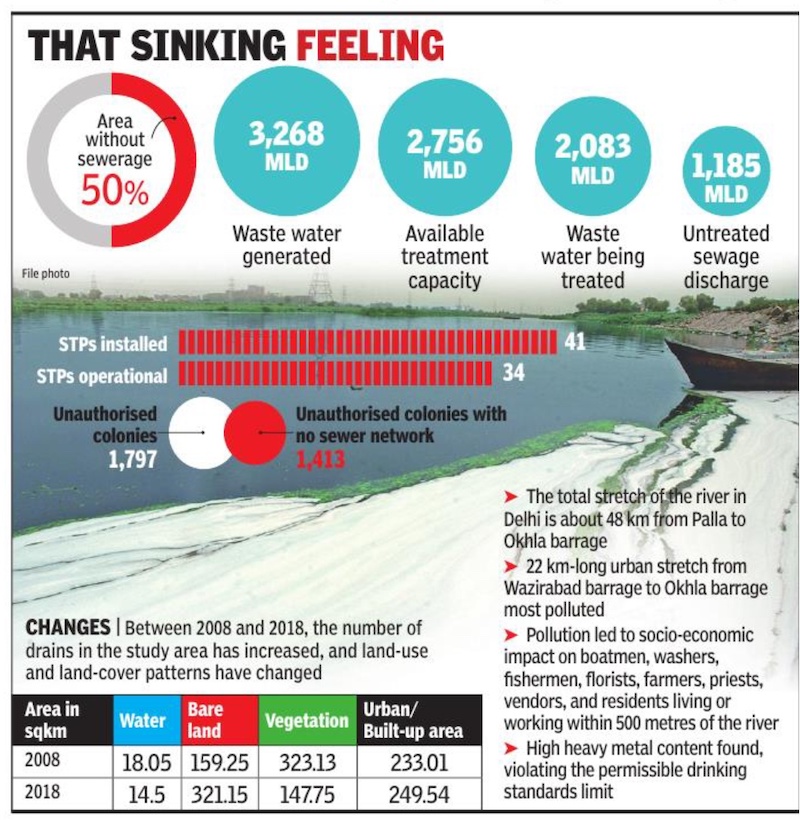
From: Kushagra Dixit, May 2, 2022: The Times of India
New Delhi: The rising pollution in Yamuna has led to a negative socio-economic impact on several communities in Delhi, especially among the low-income groups who made their permanent professions into temporary ones while suffering health issues, reveals a study by Tata Centre of Development at University of Chicago.
The study considered data between 2008 and 2018 and spoke to people relying on the river. It found that the waterbody had shrunk from 18. 05 sq km to 14. 5 sq km, bare land soared from 159. 25 sq km to 321. 2 sq km, and built-up area increased from 233. 01 sq km to 249. 5 sq km in 10 years. This further took a toll on the income and health of people involved in occupations like fishing, boat rowing, farming, washing, ritual specialists like priests at ghats, and shopkeepers selling offerings like coconut, flowers, sweets, etc.
Among those surveyed, the minimum were boatmen and fishermen. “We found only three boatmen residing on the Yamuna ghat. There used to be many boatmen years, but many changed their traditional profession due to pollution and reduced number of visitors,” stated the report, adding that a few fishermen visited when the gates of Wazirabad barrage were opened.
“The total catch of fishermen also reduced compared with 10 years ago. Now, they hardly get Rohu (Labeo Rohita) and mostly catch catfish and China fish (a hybrid species), which have less commercial value. They work as daily wage labourers, domestic help or pull rickshaws to subsist and come for fishing only occasio- nally,” the study stated. Most affected people earned either less than Rs 5,000 per month or between Rs 5,000 and Rs 10,000 per month. “Over 49% of the surveyed population, with an average five members per family, subsisted on less than Rs 10,000 per month, while 17% survived on less than Rs 5,000 per month. Most people surveyed had one or more family members working as manual labourers,” the report mentioned.
Poor economic status was making social and public services increasingly difficult to access. Only 44 % of the respondents had their own houses, while the rest lived in jhuggies, temples, night shelters, or on encroached land, specifically the farmers of Majnu Ka Tila. Only three in 10 had sewer connections. Ne-arly 17% said school-aged children didn’t attend school due to either a lack of schools in the area or shortage of funds. Those who could send their children to schools didn’t want them involved in their traditional occupations.
Priests and boatmen in Yamuna Bazar claimed that pollution was the main reason for the decrease in the number of visitors and devotees. It had adversely affected their businesses. Farmers were no longer able to grow watermelons for the past 10 years.
Speaking about the health risks of living along the river, the report stated that 55. 6% of respondents had gastro and diarrhoea-related diseases and 50% had skin diseases. “While visiting the study sites, we experienced frequent throat infections, colds and fevers,” the report pointed out.
Supratik Guha, principal investigator and professor at Pritzker School of Molecular Engineering, University of Chicago, said the solution for remediation of the river would not be possible by using technology alone, but also require sociological and economic influences.
“There are new technologies emerging for making detailed measurements of water quality, like electronics, computing, cloud-based technologies, sensing and satellite imagery. These can be extremely useful in addressing remediation for rivers like Yamuna. However, technology will not solve everything. The solutions for remediation are complex and involve sociological and economic influences and regulatory guidelines. They need creative models that can be informed and underpinned by technology,” said Guha.
The Pollutants
Ammonia
2019
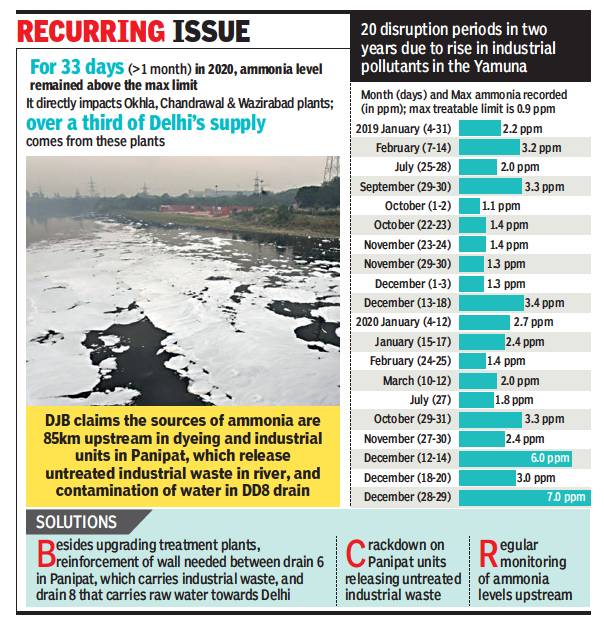
From: Paras Singh, January 3, 2021: The Times of India
See graphic:
Ammonia in River Yamuna, 2019.
Drain water
2021
Priyangi Agarwal, August 19, 2021: The Times of India
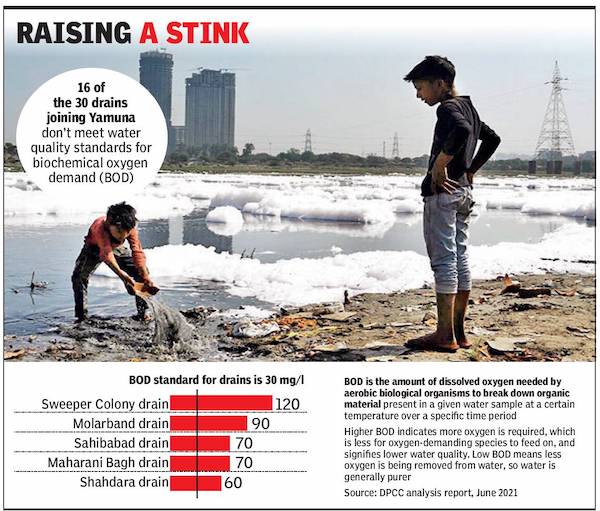
From: Priyangi Agarwal, August 19, 2021: The Times of India
A report by Delhi Pollution Control Committee (DPCC) on the assessment of water quality of drains says 16 out of the 30 drains that discharge into the Yamuna are not meeting the prescribed parameters of biochemical oxygen demand (BOD). Some drains are also flouting prescribed standards of chemical oxygen demand (COD) and total suspended solids (TSS).
Apart from analysing the Yamuna water quality at eight sites, DPCC took samples from the drains to identify the polluting ones. The latest water quality status report, which is based on the samples collected in June, stated the Sweeper Colony drain was the most polluted. It contributed 120mg/l BOD, 544mg/lCOD and 310mg/lTSS. The prescribed standards for drains are 30mg/l for BOD, 250mg/l for COD and 100mg/l for TSS.
Two more drains, which did not meet the prescribed standards of COD, were Molarband (384mg/l) and Metcalf House (256 mg/l) drains. Nine drains failed to meet TSS parameters.
A DPCC official said, “As each drain gets trapped, the improvement in water quality is accessed through these parameters. Many minor drains get merged with major drains and hence, the assessment of water quality helps in identification of minor drains that discharge a heavy load of pollutants ending up in the river.”
The analysis will also help in identifying from where sewage is entering into the system or industrial areas that discharge untreated effluents into the river, he added. The monthly report is shared with various authorities to help them improve the water quality.
According to officials, there are 18 major drains that fall into the Yamuna in the stretch between Wazirabad and Okhla in Delhi. “Of these, trap has been completed in 13 drains and two major drains — Najafgarh and Shahdara — are included in Interceptor Sewer Project where substantial flow of sub-drains under their command areas will be trapped and treated. Further, in situ treatment in these drains are also being proposed,” said a report submitted by the environment department to the Union jal shakti ministry. The report stated that for the remaining three drains, an action plan has been prepared, which requires construction of sewage treatment plants (STPs) at the mouth of two drains, Mori Gate and Barapullah.
Drains flowing into the Yamuna/ 2024
Priyangi Agarwal, July 6, 2024: The Times of India

From: Priyangi Agarwal, July 6, 2024: The Times of India
New Delhi : The Yamuna continues to be highly polluted with no significant change in water quality, according to the latest report of the Delhi Pollution Control Committee. None of the 16 drains that flow into the river have met water quality standards with respect to biochemical oxygen demand (BOD).
DPCC uploaded reports on the water quality of the Yamuna and its drains after a four-month hiatus. Among the eight locations from which samples were collected on June 25, the river was cleanest at Palla, where the Yamuna enters Delhi. The last monitoring station at Asgarpur (just beyond the confluence of Shahdara and Tughlakabad drains) was the most polluted.
Dissolved oxygen (DO), which is the amount of oxygen present in the river and the acceptable standard is 5mg/l or above, met the standard at Palla and Wazirabad but was nil at the ISBT bridge, Nizamuddin bridge, Okhla barrage, Agra Canal at Okhla barrage and Asgarpur. Low DO level affects the survival of aquatic life in the river.
Similarly, a higher BOD indicates more oxygen is required for the oxygen-demanding species to feed on and, thus, signifies lower water quality. The prescribed BOD norm for the Yamuna is 3mg/l or less, but this was met only at Palla at 2mg/l. It was 28 times higher than the standard at Asgarpur at 85mg/l, 17 times higher at Okhla Barrage (50mg/l) and 16 times higher at ITO bridge (47mg/l).
The drains that flow into the Yamuna are also polluted with BOD levels surpassing the standard in 16 drains. Eleven drains had no water. Even faecal coliform levels, which signal the presence of sewage in water, were much higher at all eight stations than the prescribed standard.
River activist Bhim Singh Rawat, associate coordinator of the South Asia Network on Dams, Rivers, and People, said, “An analysis of the water quality status of the Yamuna compared with last year shows that the river has become a monsoonal, rain-fed river. When the upper catchment of the river receives rain and gets flow, the water quality shows improvement. When there is no rain, the Yamuna remains heavily polluted. There is no control, treatment or pollution abatement in the river.”
Another activist, Diwan Singh, said, “The levels of pollutants increase after the Yamuna enters Delhi. The river has also been absolutely deprived of its freshwater flow, worsening its condition. It continues to be a sewage canal.” He added that the river seemed to have no rights since the city was prioritised rather than the river at every step.
Dyes
As in 2021
Jasjeev Gandhiok, July 9, 2021: The Times of India
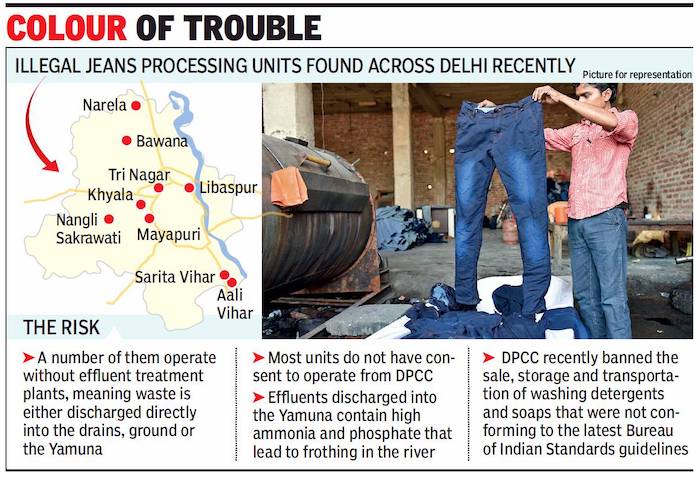
From: Jasjeev Gandhiok, July 9, 2021: The Times of India
While sewage discharged into the river accounts for much of the Yamuna’s pollution, the froth on its surface comes from an entirely different source —illegal jeans dyeing units. These mostly operate without a ‘consent to operate’ certificate or have an effluent treatment plant in place. Water discharged by such units, therefore, is high in ammonia and phosphates compounds, which are not only toxic for aquatic life, but also the cause of the thick foam on the river water.
Following a plea in National Green Tribunal in 2019, Delhi Pollution Control Committee was asked to act against all illegal jeans dyeing and washing units in the city. Till date, 155 have been issued closure orders after recent detection of these polluting units in the Khayala, Bawana, Narela and the Badli industrial areas to add to those found in the past two years in Sarita Vihar, Mayapuri and Nangli Sakrawat.
Drives were conducted in Khayala. A DPCC official said that so far, the illegal units, most without effluent treatment plants, had been fined Rs 3.08 crores. More than six units were closed and others served notices. “More closure notices will be served in the next few months,” declared the official.
Varun Gulati, the petitioner in the NGT case who also took part in the crackdown at Khayala, says groundwater is the first to suffer in areas at some distance from the Yamuna. “Drains where these units discharge waste are frothing and the dyes turn the colour of the water to red or pink,” said Gulati. “Each day, hundreds of thousands of litres are being discharged into the Yamuna. This needs to be stopped to improve the river and ground water quality.”
Bhim Singh Rawat, a Yamuna activist and member of the South Asia Network on Dams, Rivers and People (SANDRP), pointed out that while organic pollution through sewage could still be diluted by increasing the water flow, toxic dyes and chemicals not only killed good bacteria in the river water but also affected the Yamuna’s self-cleaning’ property. “If there is organic waste, the river has the capacity to clean itself,” Rawat said. “But this is not possible with chemical pollution. The dyes cannot be washed away and do not break down naturally, causing harm both to aquatic life and humans.”
Delhi’s animal husbandry department recently banned fishing at two highly polluted points in the Yamuna where the fish were likely to be toxic. DPCC too banned the sale of soaps and detergents that did not meet the Bureau of Indian Standards norms to check froth formation.
Sewage
The problem, 2015-19
Paras Singh, Sep 19, 2019: The Times of India

From: Paras Singh, Sep 19, 2019: The Times of India
The big wrought iron gates and the numerous vehicles parked outside double-storey homes signify that West Jyoti Nagar is a well-to-do colony peopled by members of the middle and upper middle classes. It might not be very apparent right away, but this east Delhi colony is indirectly associated with the Yamuna’s pollution. The area was notified as being sewer-connected in 2014, but half a decade after the sewage lines were installed, only 11.5% of the houses have actually availed of the sewage services.
According to Delhi Jal Board’s report to the National Green Tribunal, there are 1,446 active water connections in West Jyoti Nagar, but only 167 sewer connections. This means that the sewage flows into the storm-water drains and septic tanks and inevitably ends up in the Yamuna through the Gokalpuri drain. In West Jyoti Nagar, TOI found that most of the stormwater drains were indeed carrying sewage. A DJB official said that people had refused to avail of a connection. “If these residents had got illegal connections to the network, there would have been an increase in the sewage received at sewage treatment plants. But this is not the case, and so can only mean that sewage is flowing into storm water drains,” the official added.
Surender Garg, general secretary of West Jyoti Nagar RWA, disputed the DJB findings. “Some people had sewer connections before the new lines were laid 4-5 years ago and most got connected after that,” Garg said. While he did not specify the sort of connections people had before the sewers were laid, he could have been referring to use of storm-water drains for discharging sewage.
West Jyoti Nagar only stands out in this regard because of its relative affluence and the expectation that residents there would be aware of the benefits of connecting to a sewage system. The other colonies are no less indifferent. While almost the entire east Delhi can now access the sewage services, only 60% of the households are actually connected.
DJB reported that the sewer network has been extended from 255 unauthorised colonies in 2015 to 384 in 2019 and the work is in progress to further link 432 unauthorised colonies, covering a population of 21.6 lakh. “Even within the existing 951 kilometres of sewers, new lines were added,” the report said.
Another official said that DJB had recently made policy changes, including reducing the regularisation fee for illegal connections and easing the documentation required for a connection, to encourage consumers in unauthorised colonies to get linked to the official sewerage network. “People in unauthorised colonies can use electricity bills instead of property ownership as ownership proof,” he added.
While the residents of unauthorised colonies faced genuine technical problems, such as paperwork, in availing the sewage services, officials rued the lack of intent among dwellers of the more affluent areas which got on the sewer map years ago. They disclosed that DJB had requested the Union urban affairs ministry to approve of the water utility itself begin connecting houses to the sewer network. DJB vice-chairman Dinesh Mohaniya also said that NGT’s directives were being closely studied to chalk out an action plan.
Human faeces/ 2021
Dhananjay Mahapatra, February 11, 2021: The Times of India
The Yamuna is literally full of shit. The Centre informed the Supreme Court that total faecal coliform found in the river at Nizamuddin ranged between 66,000 and 1.1 crore mpn/100 ml as against the standard of less than 2,500 mpn/100 ml for potable drinking water.
In an affidavit, the Centre cited data from testing of water samples by Central Pollution Control Board (CPCB) at various places and said dissolved oxygen, essential for aquatic life, ranged from below detection level to 5.6 mg/litre as against the standard of above 5 mg/litre.
Surprisingly, the river regained its vitality by the time it reached Balua Ghat at Prayagraj just before merging with Ganga. The faecal coliform level here came down to between 300-2,100 mpn/100ml and dissolved oxygen level increased to between 7.3 to11.5 mg/litre, which is better than the readings recorded at Paonta Sahib, Himachal Pradesh.
The Centre, through additional solicitor general Aishwarya Bhati, informed a bench headed by CJI S A Bobde that it had filed the affidavit in case taken up suo motu by the SC to clean up polluted rivers, starting with the Yamuna. It said, according to CPCB, the main reason for the high level of faecal coliform in the Yamuna during its journey through Delhi was the discharge of huge quantities of untreated sewage.
“Gaps are identified in sewage generation and treatment capacities in cases of 60 cities/municipalities, including Delhi. For example, in case of Delhi, sewage generation is 3,273 MLD. But actual utilisation of STPs is only 2,432 MLD, of which 711 MLD comply with the discharge norms. This means the gap in sewage treatment capacity in case of Delhi is 2,562 MLD (3,273 MLD -711 MLD),” the affidavit said.
“Delhi and Haryana governments are required to execute approved action plans by June 30, 2021, under overall supervision and coordination of the principal environment secretary of the state concerned for rejuvenation of Yamuna river and bring all the polluted river stretches to be fit for at least bathing purpose,” it added.While there existed a huge gap between generation of sewage and its treatment capacity, the Centre said, “There is no gap in treatment and disposal of hazardous waste and industrial wastewater management”
AFFIDAVIT SAYS
Gaps are identified in sewage generation and treatment capacities in cases of 60 cities and municipalities, including Delhi
Idol immersion foam
2018

The likely impact of the idol immersions of Sept 2018.
From: Jasjeev Gandhiok, Yamuna foams at mouth after idol immersions, September 25, 2018: The Times of India
The temporary gains from monsoon seem to have already been lost: the Yamuna, which was visibly cleaner due to rain, once again wore a foamy look on Monday after thousands of idols were immersed for Ganesh Chaturthi.
Many such idols could be seen floating on the ghats — some half-dissolved, others completely intact — perhaps indicative of the Plaster of Paris (PoP) that is used to make them. Decoration material, flowers and pieces of cloth provided a grim reminder of how NGT orders continued to be blatantly flouted.
Pollution levels in the river were already extremely high, according to a test conducted by Delhi Pollution Control Committee (DPCC) on August 8. It was found that dissolved oxygen — required to sustain aquatic life — was 0 in seven of the nine ghats. DO levels should be 4 mg/l or above. Similarly, the report found Biological Oxygen Demand (BOD) to be as high as 40 mg/l at places like Kudesia Ghat against a prescribed standard of 3 mg/l or below.
DPCC officials said the immersion process, especially the usage of PoP, was likely to push these levels further up. “We have started the testing process and will compare pre- and post-immersion samples. These will also be compared with last year’s readings,” an official said.
An SDMC official claimed that while immersions were lower this year, the preparation was also a lot better. “We did not allow PoP idols to be immersed and they were kept on the ghats from where they were collected on Monday,” the official said.
A corporation worker, who didn’t want to be named, said: “Water levels have been extremely low at some locations and, as such, idols could only be half-submerged. Decoration pieces were recovered in kilos from the river.”
The use of PoP idols was banned by NGT in 2015 as they don’t dissolve easily in the river. The tribunal had later issued instructions to remove all decorations before the idols were immersed.
Experts said with Durga Puja round the corner, better preparations would be required to avoid a repeat of the situation. “Idols containing toxic dyes are immersed each year and the rules are rarely followed. Better implementation of the NGT order is required on the ground,” Manoj Mishra, convener of the Yamuna Jiye Abhiyaan, said.
Before, during and after the immersion
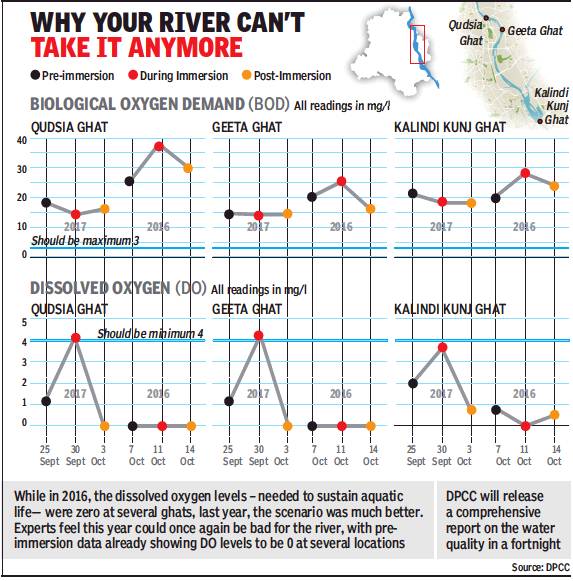
From: Jasjeev Gandhiok, DPCC to submit Yamuna report in 15 days, October 20, 2018: The Times of India
See graphic:
The state of the Yamuna- before, during and after the immersion, 2018
The situation after Dusshera/ 2018
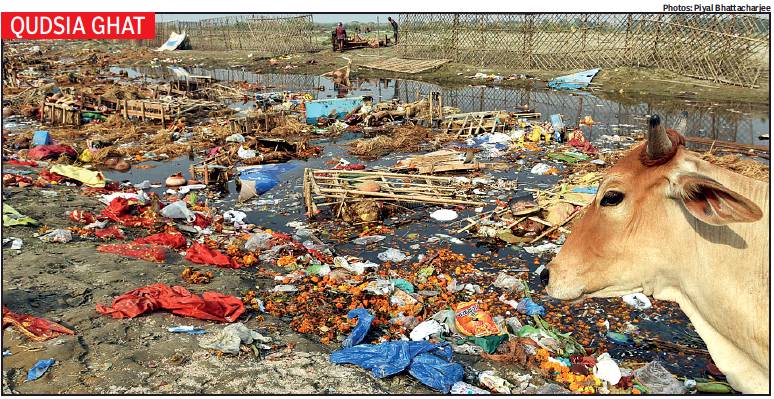
From: Jasjeev Gandhiok, After Friday fanfare, Yamuna resembles decaying waste field, October 21, 2018: The Times of India
Contract Workers Will Take A Week To Clean Remnants Of Idols, Adornments
At Qudsia Ghat, Monu Kumar wades into the Yamuna, scrounging for anything useful in the ghostly debris in the water. The scene is eerily different from the chaos and noise of Friday when hundreds of bright-hued idols reached there amid much fanfare for immersion. As Kumar pokes around, he comes across an intact Durga idol. It is probably made of plaster of Paris because even 24 hours of submergence in water has not broken it down.
The shallow stretch looks like a typhoon devastated shore village. On the ghat are large mounds of decaying flowers and muddied adornments that had been pulled off the idols before immersion. Emerging out of the water is an ugly mess of straw, sticks and wood — the remnants of the idols. Among them, disconcertingly, a limb or a beauteous eye of Durga still refuses to yield to the water’s dissolving power.
“Only around 10% of the idols this year were made of plaster of Paris since rules no longer allow the use of PoP,” says Jeetu Parchar, a contractor appointed by the North Delhi Municipal Corporation to clear the ghat after the Durga Puja festivities. “Our bigger burden is retrieving the non-soluble decorations that embellished the idols. The guidelines are that these need to be removed before placing the idol in the river, but we come across all sorts of materials, even glass, in the water.”
Ideally, only the wooden scaffolding that held the idols erect should remain in the water. Corporation officials say these are reusable and are taken to the corporation stores. Everything else is collected and sent directly to a landfill. “The task of sifting through the waste is tedious. The workers scavenge whatever is useful or can be used, but most of the muck is piled up and sent to Ghazipur,” said Parchar.
The workers are paid Rs 400 a day to clean the Yamuna, a task that lasts almost a week. “We lift out 50 to 60 idols each day, and it takes seven-eight men to take these out of the river,” said Ashu Kumar at Geeta Ghat. “The larger idols are almost impossible to drag out and we have to resort to cranes. We do end up getting a decent amount of money.”
As the contracted workers go about their work at Geeta Ghat, a group of children huddle together a few metres away. They are discussing their finds. As here, the immersion sites at Hathi Ghat, Qudsia, Kalindi Kunj, Shyam Ghat, Sur Ghat, Yamuna Ghat, DND Flyway and Mayur Vihar Extension Ghat provide some pickings for scavengers in the form of baubles and trinkets to sell in the market. They also come across coins, sometimes even damp currency notes.
Monu Kumar, employed to clean the river, admits he himself has not had much ‘luck’ in this department. “Most items of any value are taken by scavengers on the immersion day itself. Those who don’t get anything return at night, so you rarely find anything of worth the day after,” reasons the 25-year-old.
There was one more chance for ragpickers on Saturday, a day after Vijayadashmi, when some puja committees arrived to consign their idols to the river. “We avoided Friday because we knew it would be too crowded,” explains Ramesh Verma, who has come from Sultanpuri. “Usually, we immerse our idol a day later when the ghats are freer and we can go to the deeper parts of the river to ensure proper submergence. The portions demarcated at the ghats are always shallow, and it is an insult to Goddess Durga to leave her wallowing half out of water.”
Phosphates, surfactants
2020
Priyangi Agarwal, January 25, 2021: The Times of India
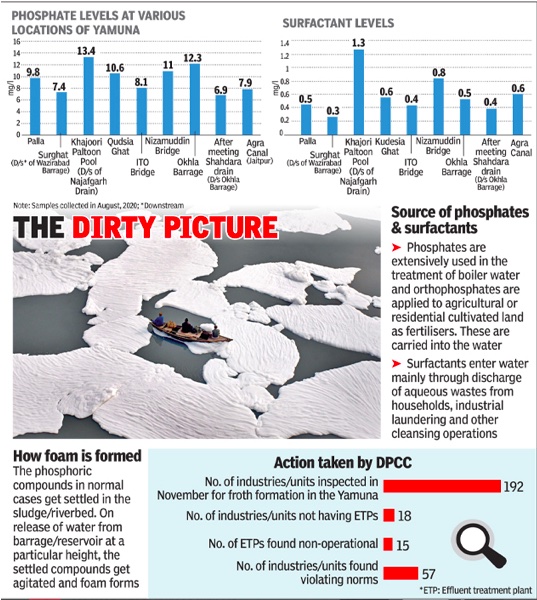
From: Priyangi Agarwal, January 25, 2021: The Times of India
Why you can’t wash your hands of froth in Yamuna
NEW DELHI: A study conducted by Delhi Pollution Control Committee (DPCC) on the formation of froth in the Yamuna has stated that the toxic foam was created mainly by the presence of phosphates and surfactants in the river.
The National Green Tribunal-appointed Yamuna Monitoring Committee, which had asked DPCC and Central Pollution Control Borad (CPCB) to submit a report on the issue, stated in its fifth report to NGT that the primary reason was high phosphate content in detergents finding their way into the river through various drains.
According to DPCC, the phosphate and surfactant concentrations were found to be higher than the standard norm in the Yamuna. While surfactants come mainly from households, industrial laundering and other cleansing operations, phosphates are used extensively in the treatment of boilers.
The samples were collected in August from nine locations, including the drains at Najafgarh and Barapullah and the supplementary drains, and treated water from sewage treatment plants (STPs), to identify the pollutants in the river.
The DPCC study revealed that the phosphate level ranged from 6.9mg/l to 13.42mg/l while the surfactant level varied from 0.27 mg/l to 1.28. The maximum phosphate and surfactant concentrations were observed at Khajoori Paltoon Pool—downstream of Najafgarh drain—with 13.42 and 1.28mg/l, respectively. The prescribed standard for dissolved phosphate is maximum 5.0mg/l and for surfactant, 0.2mg/l.
According to the study, at the outfall of Najafgarh drain before it falls into the Yamuna, the phosphate level was 74.8 mg/l. “The study indicates that phosphate contribution is from the upper stretches of Najafgarh drain. It may be due to stagnation of water, eutrophication, or degradation of organic matter within the drain and deposition of water hyacinth at the long stretch of Najafgarh drain. At upstream of Okhla Barrage, such kind of deposition of water hyacinth was found due to the presence of high amount of nutrients.”
Meanwhile, the surfactant level at upstream of Najafgarh and outfall of Najafgarh drain before its confluence with the Yamuna was 1.18mg/l and 2.17, respectively. The 62km-long Najafgarh drain receives waste water through several sub-drains and most of it is from industrial units located along its basin.
CPCB said, “Use of detergents and foaming agents has increased substantially due to awareness among public to maintain hygiene as a precautionary measure to protect from Covid-19.” The presence of surfactants and phosphates was observed at three monitored locations between downstream Wazirabad and downstream Okhla, indicating discharge of untreated sewage or partially treated sewage or industrial effluent containing laundry chemical, it stated.
CPCB recommended that the entire sewage generated from the stretch of Delhi required proper treatment and all detergent-manufacturing units in the country should be directed to manufacture detergents only as per the Bureau of Indian Standards specifications after obtaining the BIS certification.
The monitoring committee said, “The problem arising due to the release of detergents with high phosphatic contents into rivers and waterbodies will remain till the manufacturers comply with the BIS standards for detergents.”
DPCC, which is running a drive against industries in this matter, said its teams had inspected 192 units, of which 102 were polluting the Yamuna. Of these, 18 units didn’t have effluent treatment plants (ETPs) while 15 ETPs were non-functional. DPCC has issued showcause notice to 17 units and closure notice to another 39.
2024
Kushagra Dixit, Oct 18, 2024: The Times of India
New Delhi : Nonylphenol ethoxylates are banned for inclusion in detergents in many countries, but India has no r egulations. Like nonylphenol (NP), it is a chemical compound called a surfactant. Compounds of this sort are a major cause of frothing in the Yamuna, a visible proof of the pollutants in the river. Now, Toxics Link, an environmental research organisation, and US-based non-profit Environmental Defense Fund have released a report that highlights how the harmful NP and NPEs are in widespread use in India.
NP is an endocrine-disrupting chemical and was banned by India in 2009 in the cosmetics sector, but it remains prevalent in surfactants and other consumer products. It is toxic to aquatic organisms and also interferes with reproduction, development and other physiological processes in humans and animals.
The report, ‘Nonylphenol — An Endocrine Disrupting Chemical’, details how India exports surfactants to, among others, Vietnam, China and the European Union, though import volumes have decreased due to regulatory concerns. The presence of NPEs in detergents also impact textile products, causing export challenges, especially to countries with strict regulations like the EU.
NP and NPEs are widely used in Indian industries related to textiles and leather, detergents and cleaning products, paper and pulp, food packaging, cosmetics, const- ruction, a utomotive, agrochemicals, paints and metalworking fluids, the report says.
According to the California Environmental Protection Agency, NP causes poisoning in fish, aquatic vegetation and aquatic invertebrates. Studies have also established that NP has a detrimental effect on human immune, nervous and reproductive systems. It has the ability to imitate the female sex hormone oestrogen and disrupt hormonal systems. NP gets released into the environment during the manufacture and usage of detergents and also through wastewater. The chemical accumulates in aquatic organisms and remains in the environment for long periods. It enters the human body through contaminated food, particularly fish.
Suggesting the use of safer, cost-effective, technically viable alternatives available, the study points out that the transition towards safer options is slow in India. “Nonylphenols have been detected in human breast milk, blood, and urine and have been proven to interfere with the way hormones work in humans and animals,” said Satish Sinha, associate director, Toxics Link. “Concerned with its implications, several countries have restricted the use of the chemical. It is wise for India to act on this chemical.”
The report says that innovating and developing safer alternatives can make India a major player in the sustainable global marketplace. Hisham Mundol, chief advisor (India), Environmental Defense Fund noted, “The health benefits are self-evident and the faster the action, the faster will the benefits accrue. On the economic front, there is increasing momentum towards phasing these chemicals out and adopting safer alternatives will strengthen Indian industry’s reputation and business opportunities at home and abroad.”
Riverfront planning
1913-2000
Feb 11 2015
Jayashree Nandi
Riverfront planners caught in time warp
Govt trying to urbanize Yamuna since 1913: Scientists
Delhi had planned for a riverfront for Yamuna as early as 1913 to give the new capital an aesthetic promenade from Wazirabad in the north to Indrapat (Purana Qila and its surroundings) in the south.Hundred years on, the central government continues to idealize urban riverfronts like that of the Sabarmati and has been floating proposals to make Yamuna an urban infrastructure component such as dredging it to make it navigable. Awadhendra Sharan, associate professor at Centre for the Study of Developing Societies, whose research paper on Yamuna was published in Elsevier's journal of City , Culture and Society, traces how various authorities at different times in history tried to develop the river and the riverfront.
Around 1956, the Town Planning Organization suggested development of a riverfront for recreational activities with playgrounds, swimming pools, and fishing and bathing areas. “It drew attention to the possibility of taming the river by building a dam,“ writes Sharan.
Cultivation of melons on the banks in summer and fishing were common in Okhla. Floods were an annual phenomenon but there was ample land for free flow of river during the monsoon months. A new phase of urbanizing the river began after Independence in 1955-56 leading to floods becoming a health issue with w aste water discharge points near the river affecting quality of drinking water. In 1990, DDA too planned several urban projects to integrate the city and river.
Over the past two decades, Yamuna became extremely polluted and ceased to be a peren nial river. This is when the gov ernment started blaming squatters in illegal colonies along Yamuna for the pollution and began pushing “technologi cal solutions“. One of the major changes in approach is marked by the high court nod to the Com monwealth Games Village. Sha ran recollects in his paper how there were discrepancies in var ious technical reports submit ted to the court on the impact of Games Village which led to the court deciding that the area for it was not on the floodplains.
Another high court decision in March 2003 led to removal of the Yamuna Pushta slum clus ter. But various studies and ex perts say this will not help ad dress pollution.Sharan suggests the “precautionary principle“ should have been applied before such irreversible changes--like building Akshardham and the Games Village--were made. “I have tried to argue from all the historical evidence that's availa ble that we should leave the river as it is and not convert it into a re al estate operation. That makes more economic and ecological sense,“ Sharan says.
Yamuna riverfront development plan
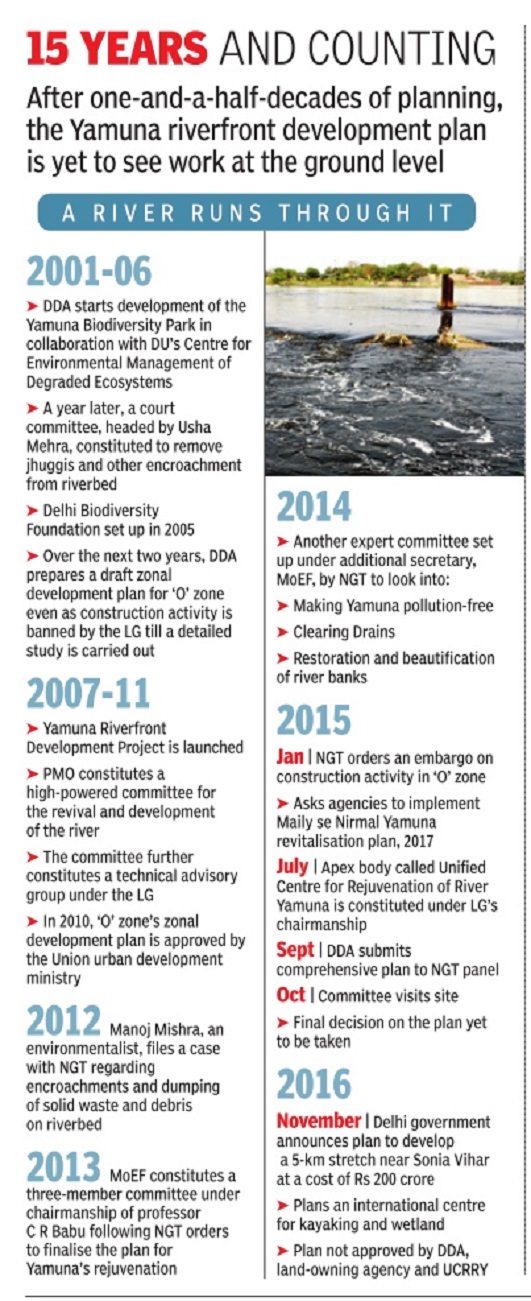
The Times of India
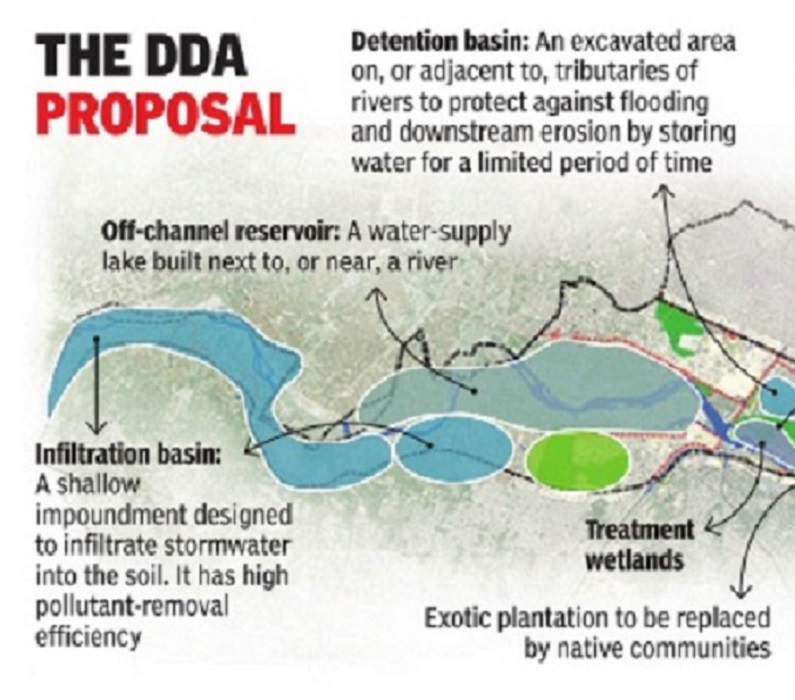
The Times of India
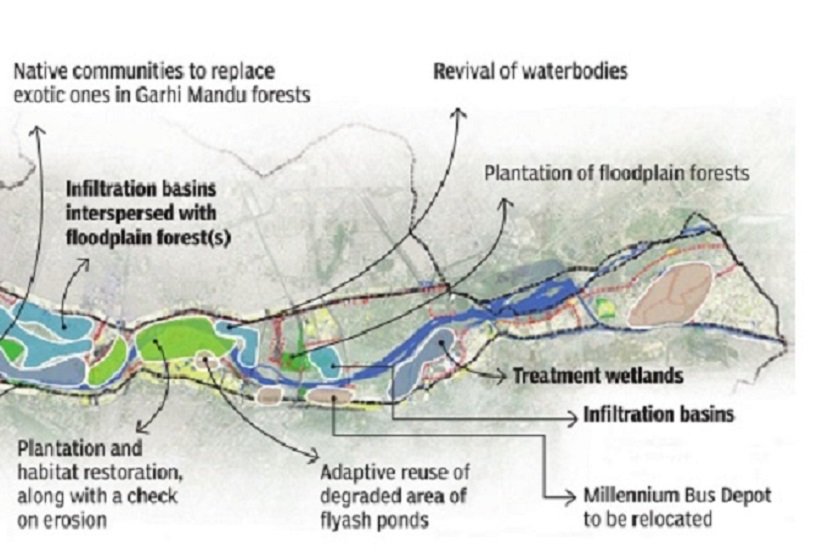
The Times of India
See the graphics on this page including 'Yamuna riverfront development plan, 2001-16' and 'Yamuna riverfront development plan, DDA’s proposal of 2016'
2018: results of DDA’s Asita begin to show
Sidhartha Roy, Revamp tilts balance in Yamuna banks’ favour, December 6, 2018: The Times of India
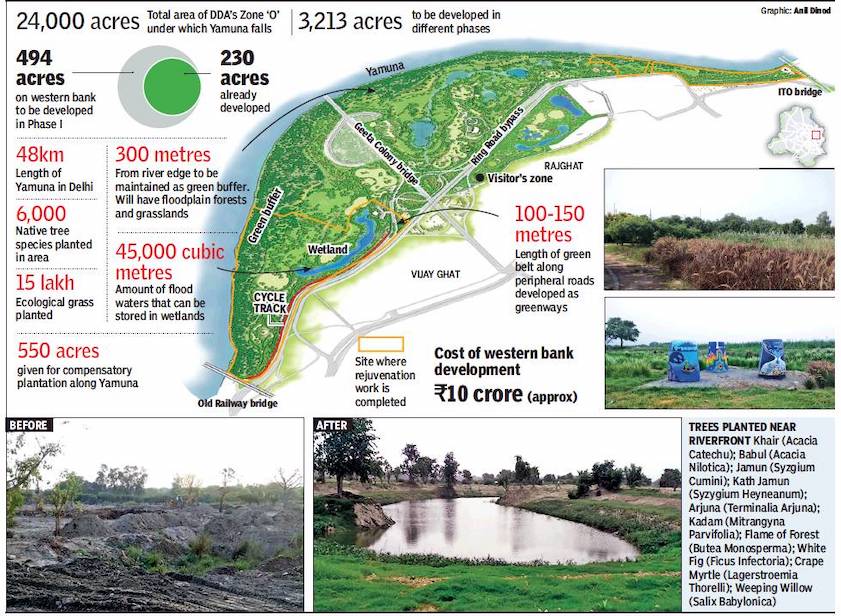
From: Sidhartha Roy, Revamp tilts balance in Yamuna banks’ favour, December 6, 2018: The Times of India
DELIVERING HIGH INTEREST: Half Of Area Under First Phase Of DDA’s Rejuvenation Project Developed And Partially Opened To Public
In 2017, Delhi Development Authority embarked on its long-planned project to develop, restore and rejuvenate the Yamuna riverfront and the results are now showing. The project, named Asita after the other name of the river, is being carried out in four phases, and nearly half of the area under Phase 1 has been developed and partially opened to the public.
The change in the landscape of the floodplain between Old Yamuna Bridge and ITO Bridge is striking. The earlier barren plain is now lush green thanks to the thousands of trees and tall grass planted in the area. Pathways have also been created along roads for nature trails, with care taken to avoid use of cement. In some open areas, artworks have also been installed.
In Phase 1, DDA had taken up 494 acres of the Yamuna’s western bank between Old Yamuna Bridge and ITO Bridge. In the past year, parks, recreational areas, green walkways, cycle tracks, wetlands and a green buffer area have come up on approximately 230 acres.
“People are flocking to the area developed as visitor’s zone, particularly in the early mornings,” said a DDA official. The agency undertook the restoration and rejuvenation of the river floodplain according to the comprehensive plan approved by the National Green Tribunal-constituted Principal Committee. “The project is being constantly monitored by an NGT committee,” the official added.
Species of riverine ecology have been planted on a green buffer area along the river’s edge, a green belt of 100 to 150 metres has been developed along the peripheral roads, which includes a continuous trail of natural pathways.
“Wetlands with a 45,000-cubic-metre capacity have been created to store the flood waters and thus revive the ecosystem function of the floodplain,” the official said. “To bring about improvement in the air quality of the city and rejuvenation of the floodplain, DDA has planted around 6,000 native tree species, apart from 15 lakh ecological grasses.”
She added, “The area has natural depressions, where we are trying to store water in a natural manner, without resorting to artificial methods.” Before the degradation of the floodplain, these depressions filled up with flood water during the monsoon season and eventually recharged the floodplain.
“We are trying an ecological revival of the river floodplain using natural methods. This kind of restoration has not been done anywhere else in the country,” the official asserted.
Apart from developing wetlands and buffer zones, DDA has earmarked some open areas where people can come for recreational purposes and spend time with nature.
The reason why DDA could only develop 230 acres of the 494 acres taken up in Phase 1 development is because most of the land that could not be developed is under litigation. These areas have encroachments in the form of illegal shanties and agricultural land. The Supreme Court has imposed a stay on any changes being implemented there till December 2019. The official said that the land-owning agency was pursuing the case.
Also, DDA is concentrating on developing the western bank of the river because large parcels of land on the eastern bank belong to the irrigation department of the Uttar Pradesh government. Because of the land owned by UP lying parallel to the road running on the eastern side of the river, DDA has found itself deprived of access from the road and so unable to develop its own riverside expanses.
A part of the land has also been set aside for other purposes. The official explained, “DDA has given land in the floodplain measuring approximately 550 acres for compensatory plantation of a riverine nature for various infrastructure projects.”
Vegetables grown on Yamuna plains
2015/ Banned by NGT; 2019/ Continues nevertheless

From: Jasjeev Gandhiok, Why veggies grown near Yamuna are bad for you, February 3, 2019: The Times of India
Consuming freshlooking spinach or a cauliflower, especially when you live near the Yamuna floodplains, does not come without a risk. If grown on the floodplains — an activity banned by National Green Tribunal (NGT) in 2015 — the vegetables may contain high levels of pollutants and heavy metals.
While growing edible food items was banned on the floodplains till the Yamuna was made “pollution-free and restored to its natural wholesomeness”, very little has changed in these three years, and several farming zones dotting the landscape will be visible as you make your way across the Yamuna on any of its flyovers. Farmers also use the contaminated river water to wash the produce, apart from using insecticides and pesticides to facilitate growth.
As per the NGT order, farmer can grow only non-edible items like flowers, and no food item. However, “very little has been done to curb the problem. The closer you are to the river, the higher the chances of the produce being contaminated due to the river and this can be extremely harmful to people,” said Manoj Mishra, convener of Yamuna Jiye Abhiyan.
The directive was issued following a plea by Mishra that had sought a shift to organic farming or shifting farming areas. “Delhi Development Authority (DDA) was supposed to be the agency to curb this, but you can still see violators. While some farmers have shifted to non-edible plants, a number of key vegetables continue to grow on the Yamuna plains. A systematic approach is needed to change it,” Mishra said.
The extent of the problem was also highlighted in a 2012 report by The Energy and Resources Institute (Teri), which tested vegetables grown along the floodplains. Not only were heavy metals discovered, but the study, ‘Yamuna, the poisoned river’, also found their levels to be several times over the permissible limits at some places. At one location, the lead content was 10 times higher than in other areas, while soil samples revealed high quantities of nickel, chromium and mercury — ranging up to 40 times the permissible limits. The mercury concentration was often almost 200 times the permissible limits.
The study also found the highest contaminants in spinach, followed by cauliflowers. “The concentration of heavy metals was found to be highest in spinach, followed by cauliflower and the least in radish. These vegetables become the carriers of heavy metals in our food chain.”
Satish Sinha, associate director at Toxics Link, an environmental NGO, said health effects of these vegetables could be crippling in the long run. A DDA spokesperson said there was a court stay on evicting farmers from the floodplains till December 2019.
2019/ Ban removed
Ritam Halder, July 26, 2019: The Times of India

From: Ritam Halder, July 26, 2019: The Times of India
After four years of a ban on cultivation on the Yamuna floodplain, the panel appointed to monitor the pollution of the river has recommended that farmers may be allowed to grow crops and vegetables but with regular and constant watch on the metal content and pesticides levels present in the harvested produce.
The recommendation of the committee comprising former Delhi chief secretary Shailaja Chandra and retired expert member BS Sajwan came after the report of the study carried by scientists at National Environmental Engineering Research Institute (CSIRNEERI) said, “The farmers may be asked to maintain or provide relevant details with respect to their land under cultivation, type of crops grown, quantity and source of water used, type and quantity of fertilisers, pesticides or any other substance used for different crops in different seasons. At the same time, metal or pesticide contents present in the vegetables sold in different areas of Delhi, and also grown under organic farming needs to be analysed periodically, to ascertain that levels of metals and pesticides are within the safe limits of human consumption.”
The study, ‘Metal Content in Vegetables, NEERI Study (2019)’, analysed data from three locations — Usmanpur Khadar, Geeta Colony and Mayur Vihar — and seven vegetables — cabbage, cauliflower, radish, brinjal, coriander, fenugreek and spinach. “Though the levels of metals present in the vegetables were found within FSSAI limits (except for lead), monitoring and testing of heavy metals in vegetables as well as soil and irrigation water along with water of river Yamuna should be carried out by authorities on a regular basis,” the report said.
Prolonged consumption of food with unsafe concentrations of heavy metals can lead to disruption of biological and biochemical processes in the body. Heavy metal toxicity can lower energy levels, damage the functioning of the brain, lungs, kidney and liver, damage blood composition, and even cause cancer.
“Possible sources of lead are industries dealing in automobiles, battery, paint, polythene, pesticides and lead processing unit. Various usages of lead based compounds may be potential source of lead. Farmers should also be made aware of adverse effects associated with excess use of certain pesticides, insecticides, chemical fertilisers, irrigation water (if contaminated) during cultivation. Organic farming may also be explored or encouraged in these areas,” the NEERI report said, adding that the findings were being submitted to NGT with a request to direct Central Pollution Control Board to undertake such studies periodically to allay public apprehensions about health-related aspects of vegetables grown on the floodplain.
Food Safety and Standards Authority of India (FSSAI), an autonomous body established under the Union health ministry, and CPCB too have together conducted tests on the vegetables and fodder grown on the banks of the Yamuna. “The result of the FSSAI study on summer vegetables will be available by July,” the second interim report of the monitoring committee said.
NGT had banned growing of vegetables on the floodplain in 2015. “This direction shall be strictly adhered to till the Yamuna is made free and restored to its natural wholesomeness,” the order of January 13 of that year said. After meeting the two-member monitoring panel last year, Delhi government had agreed to run a campaign to dissuade people from eat produce grown on the floodplain “as this leads to entry of toxins in the food chain”.
